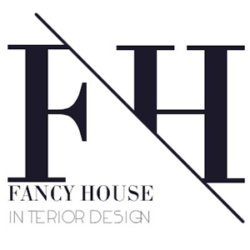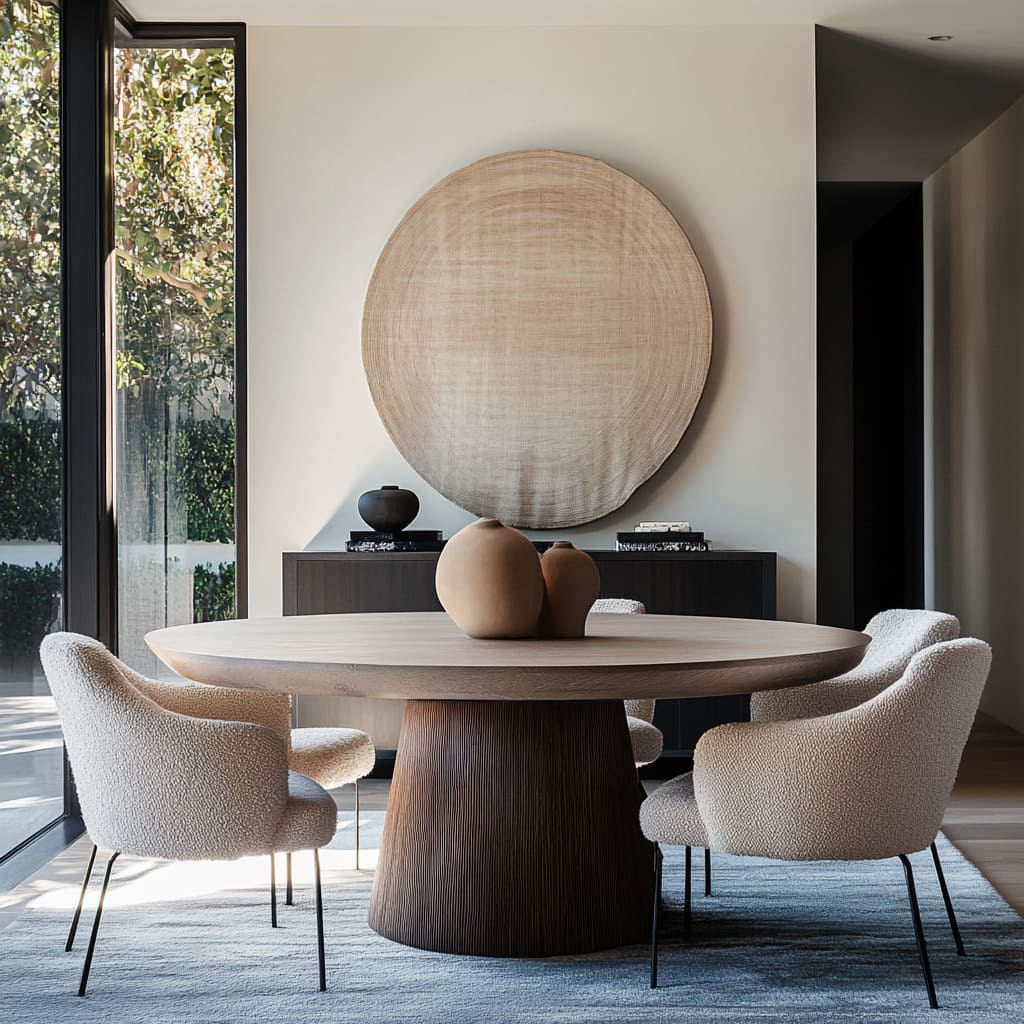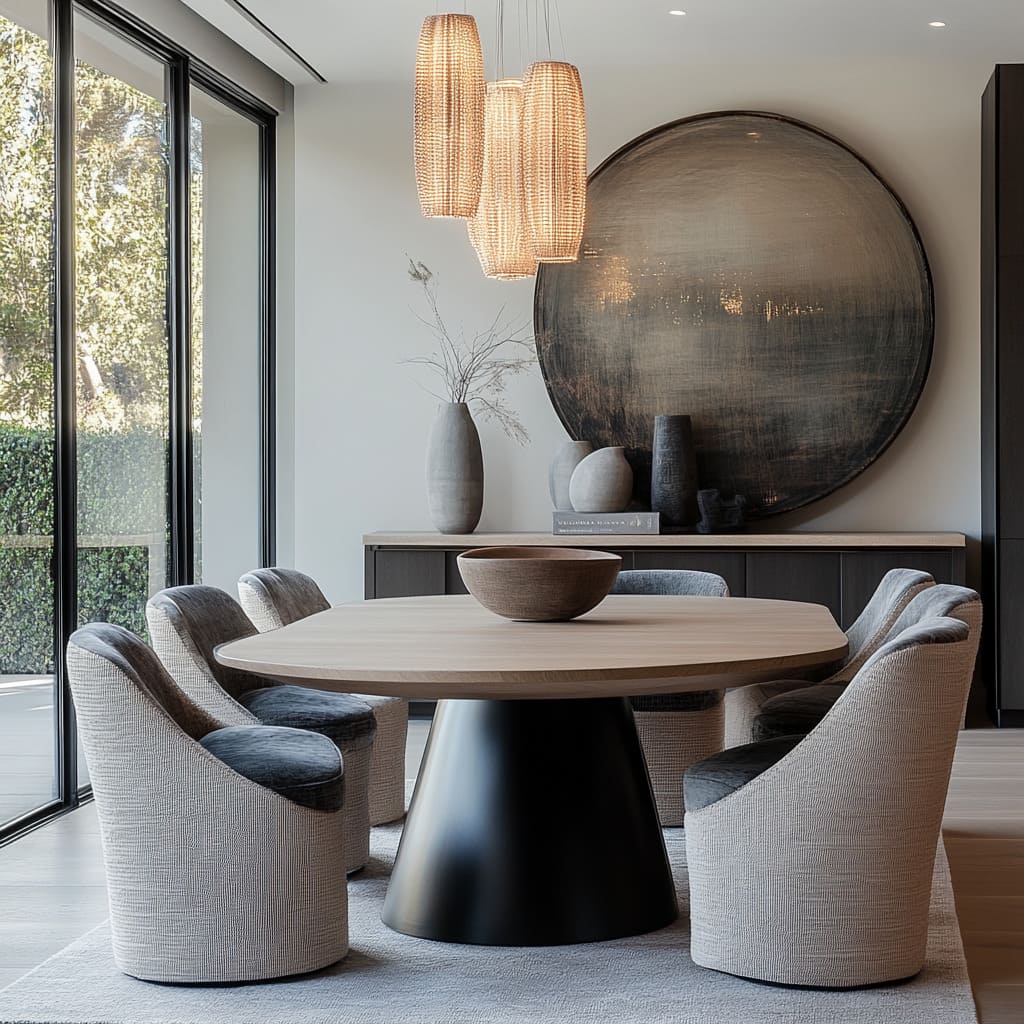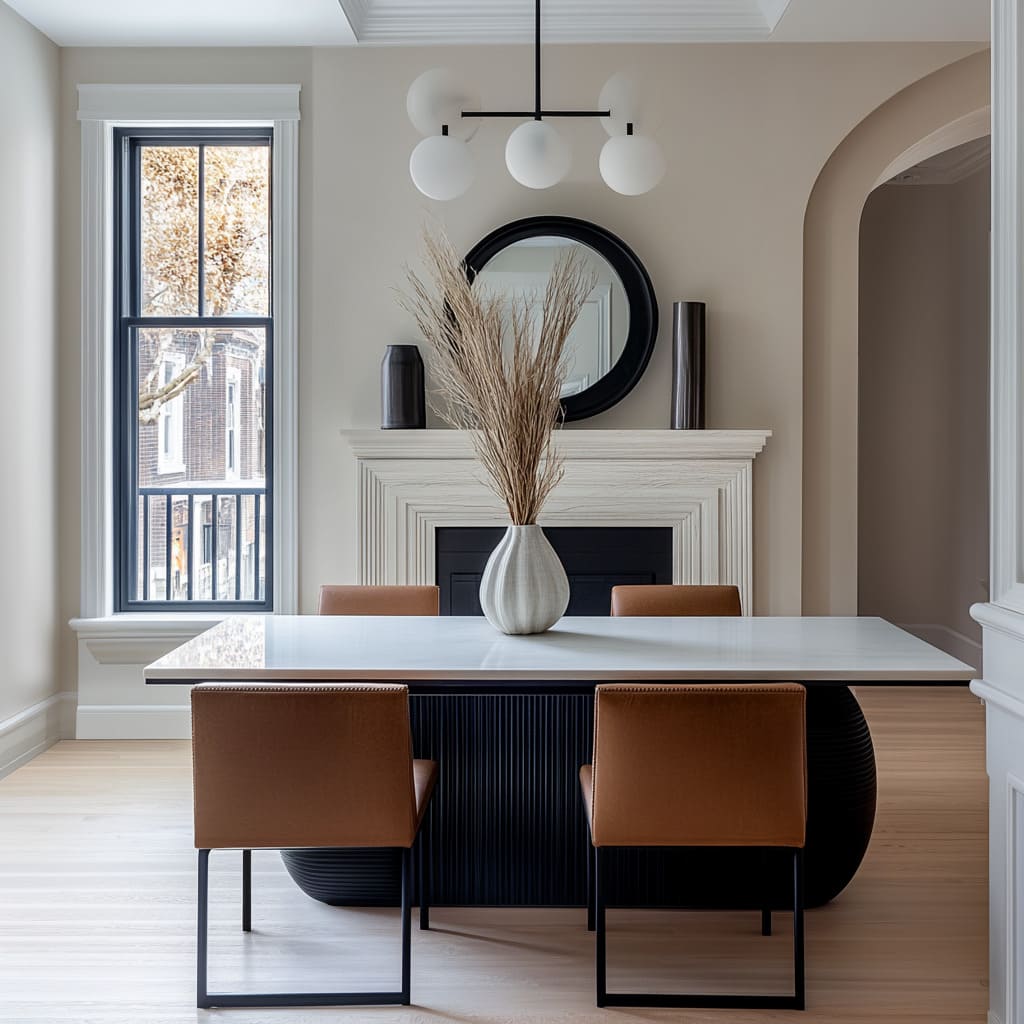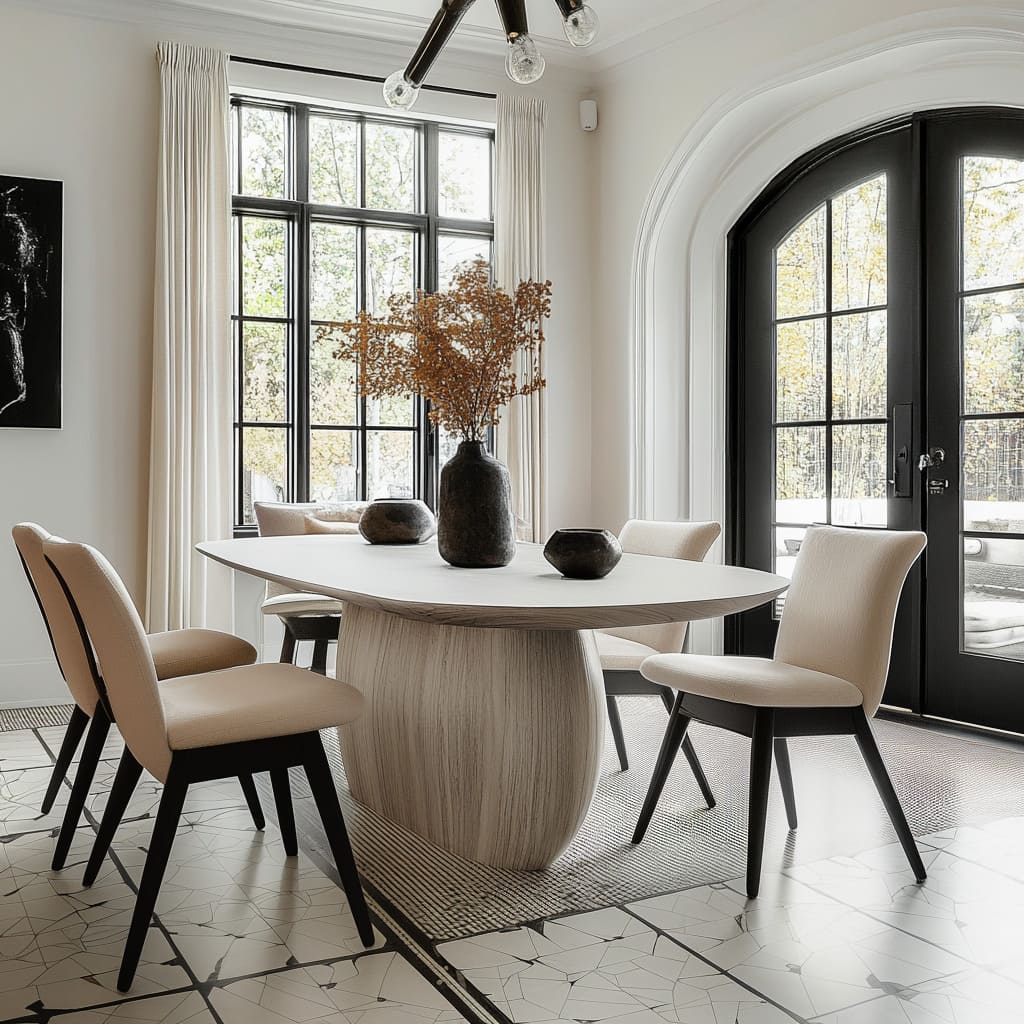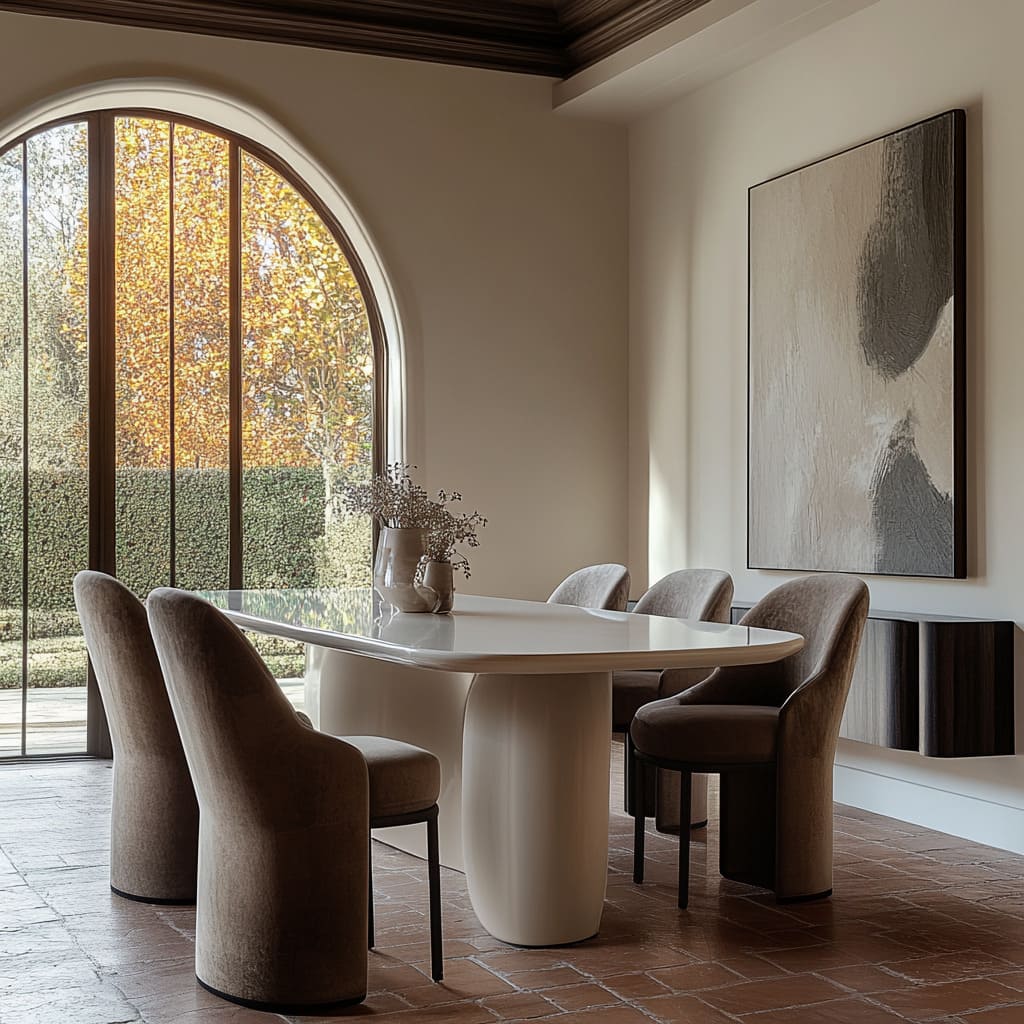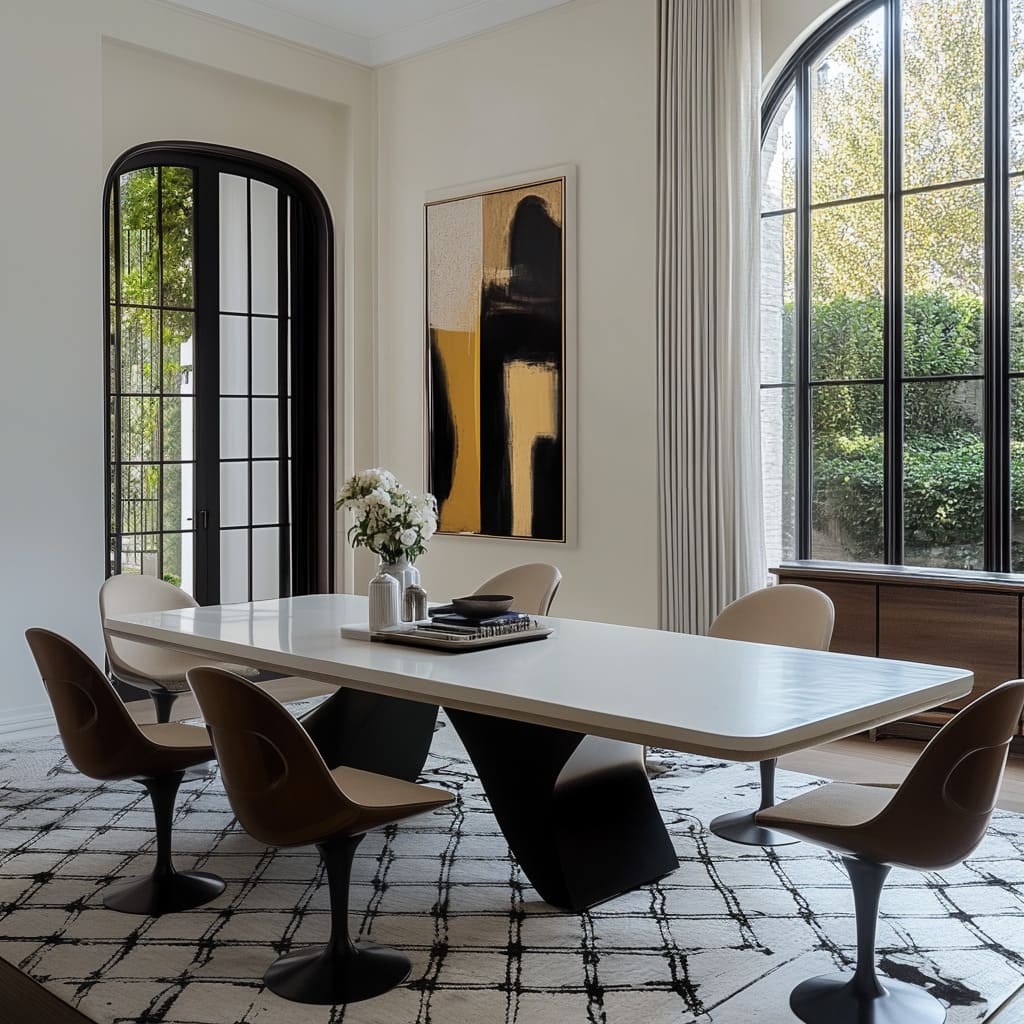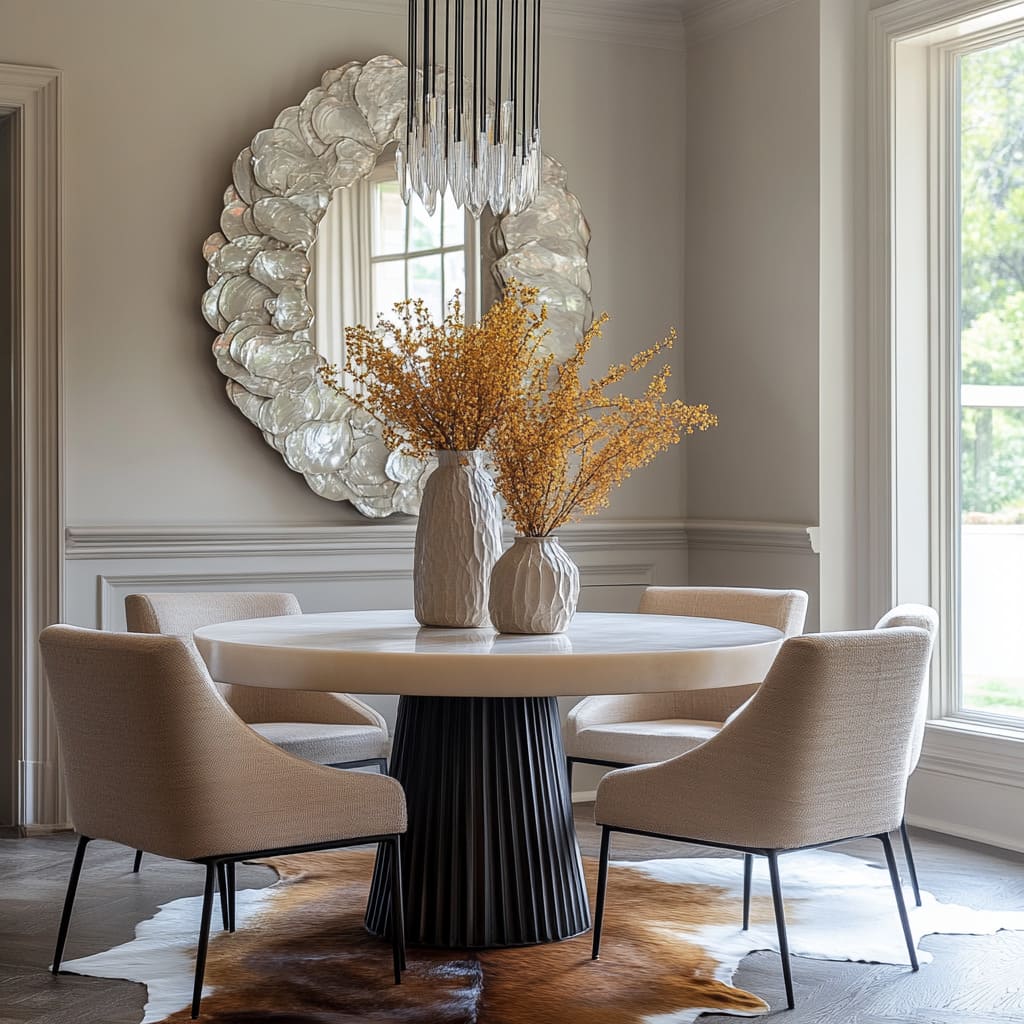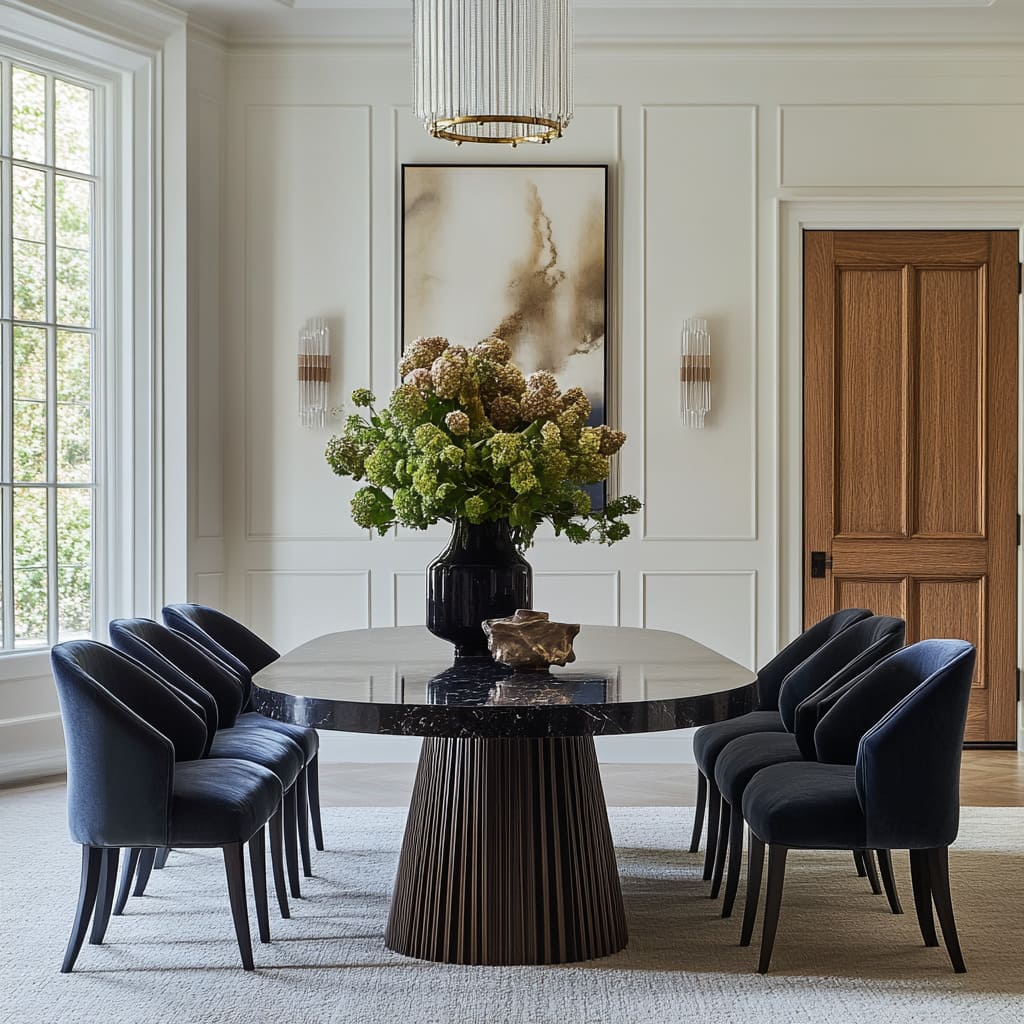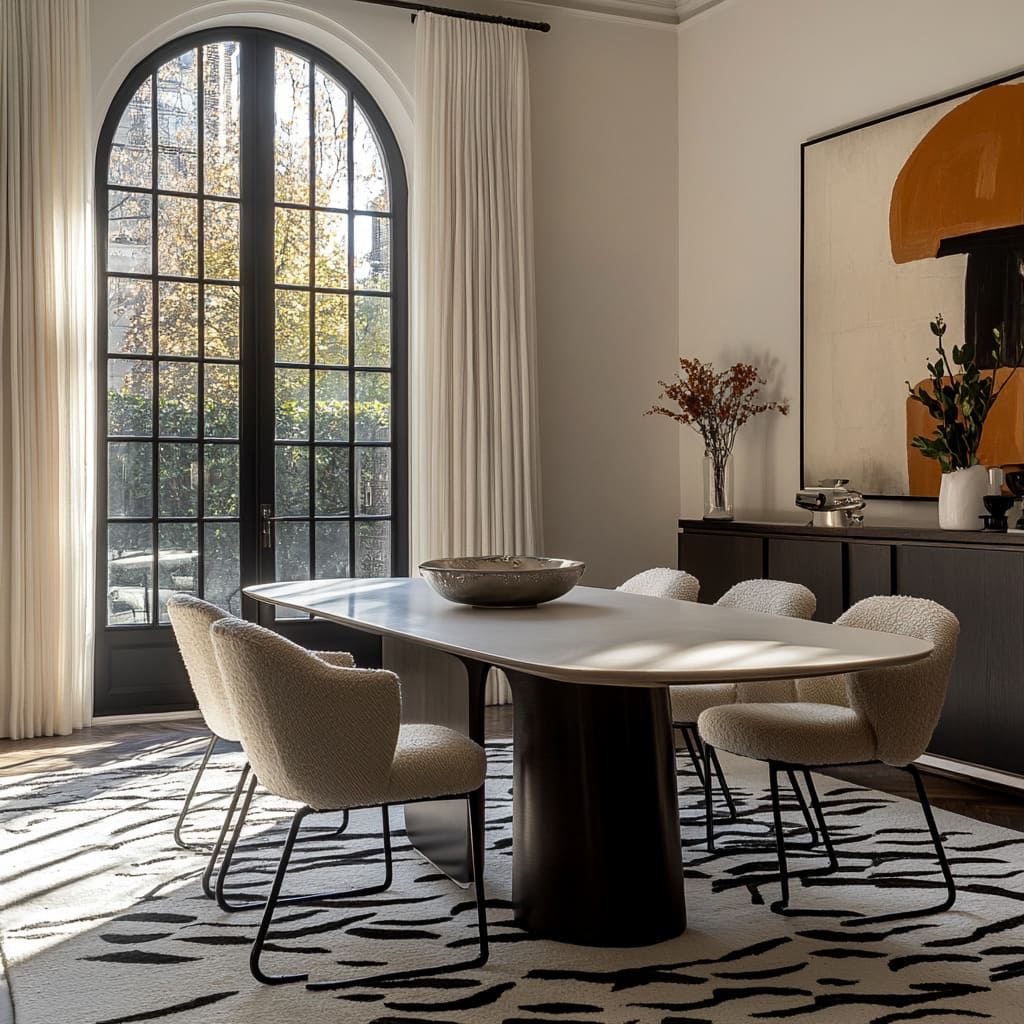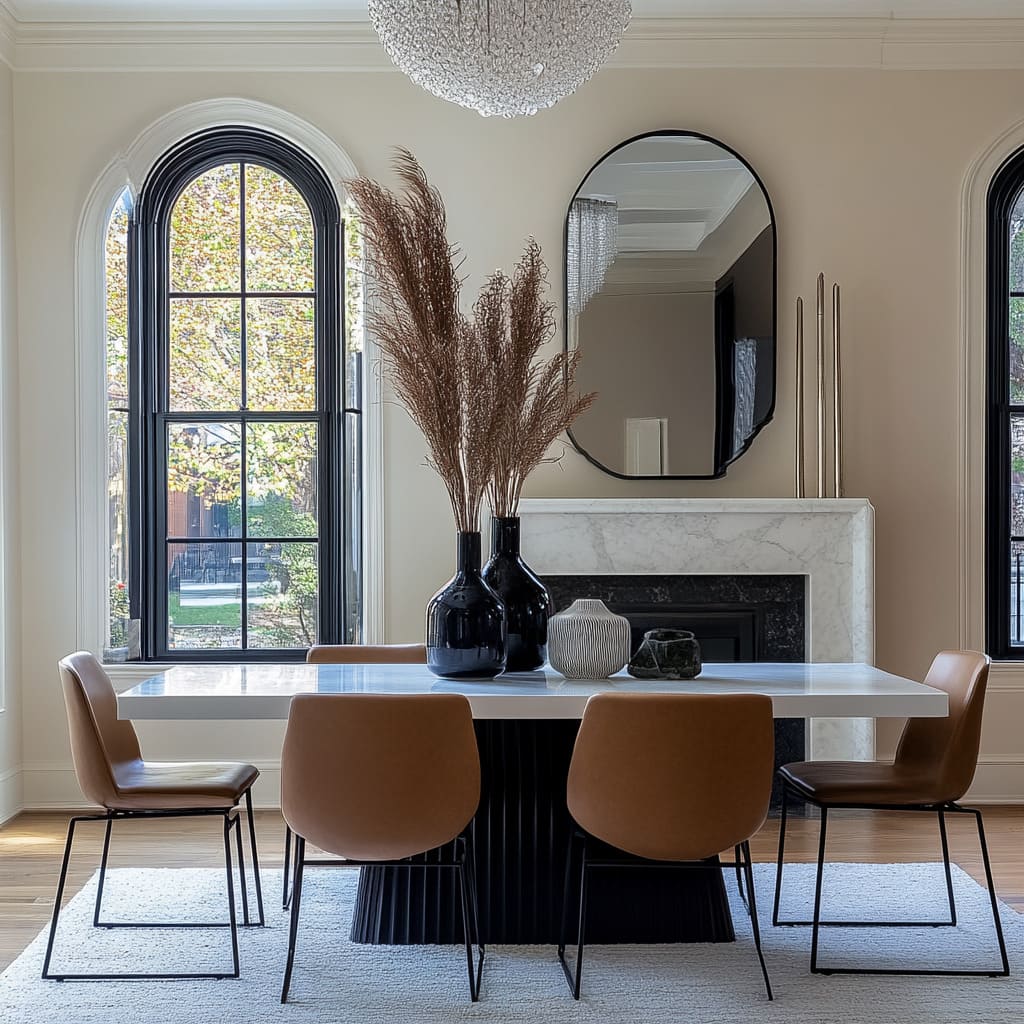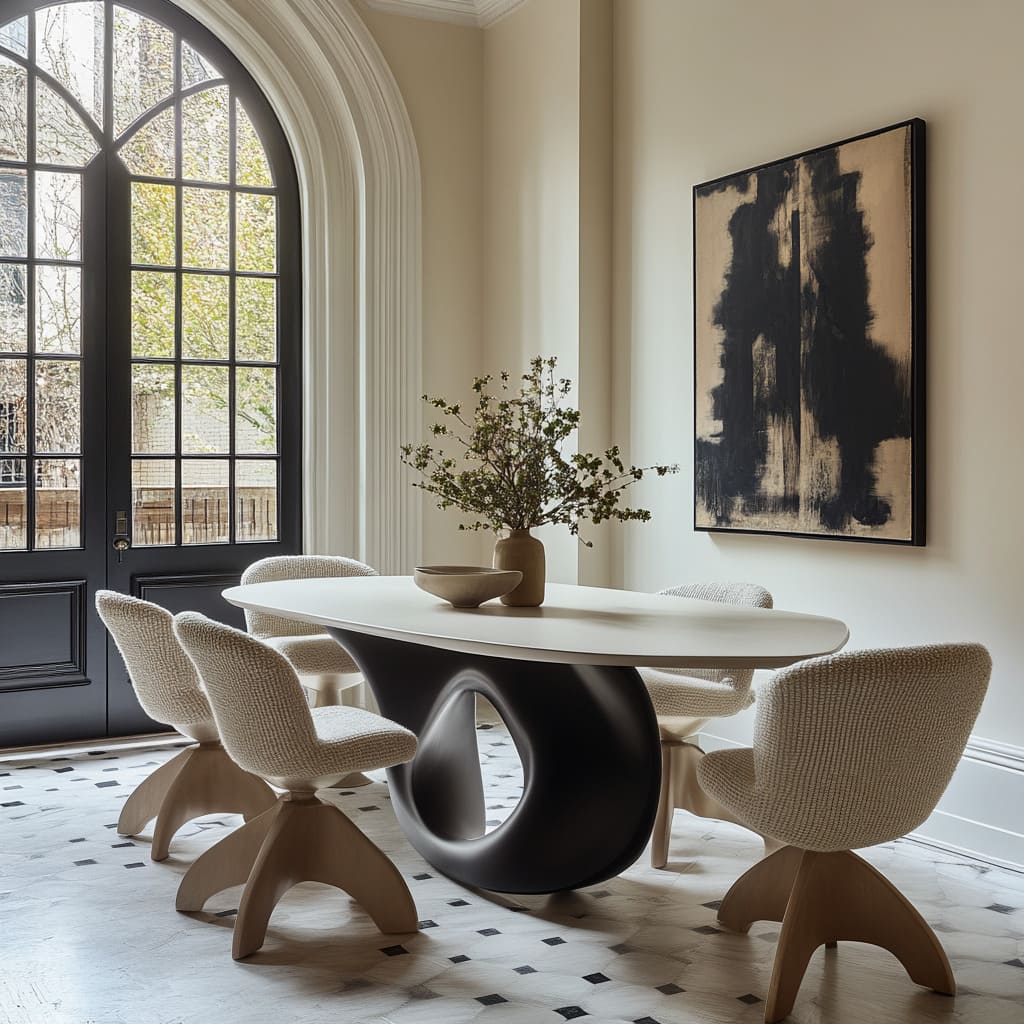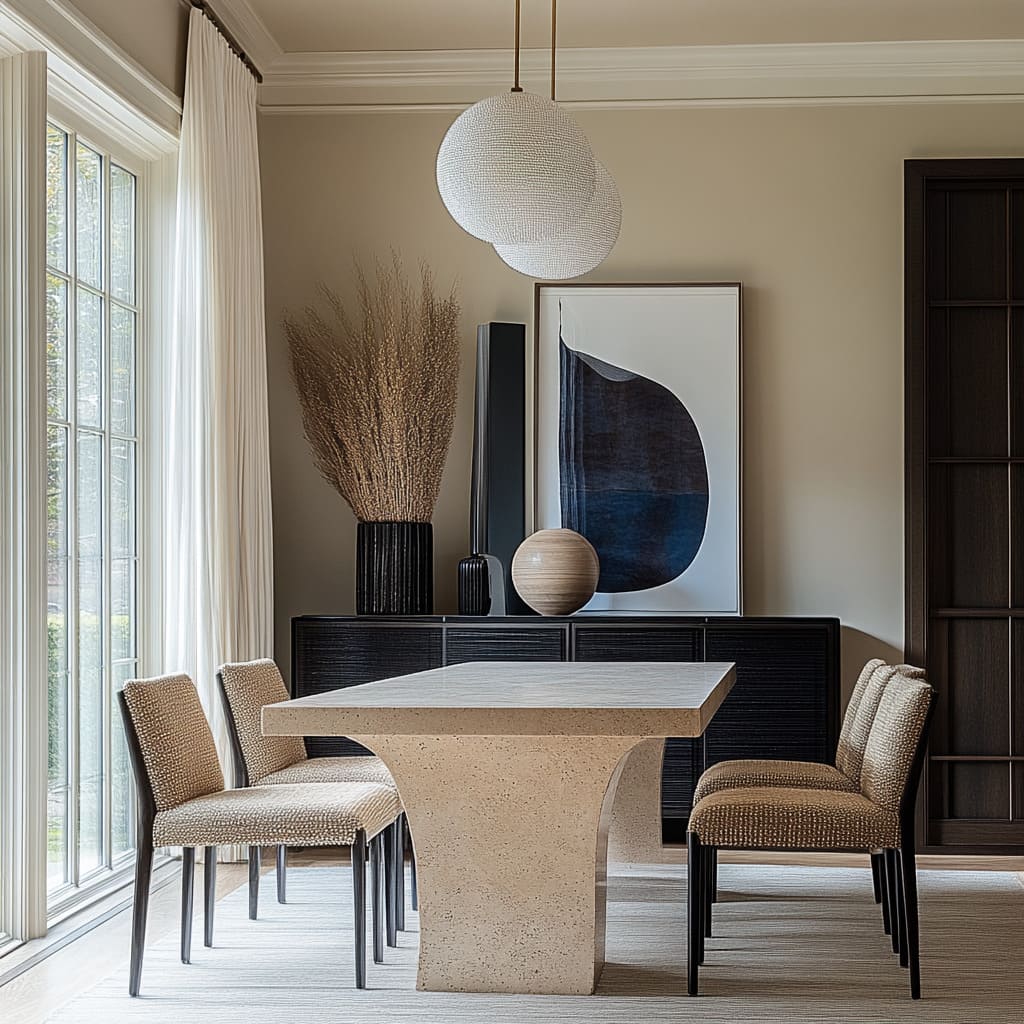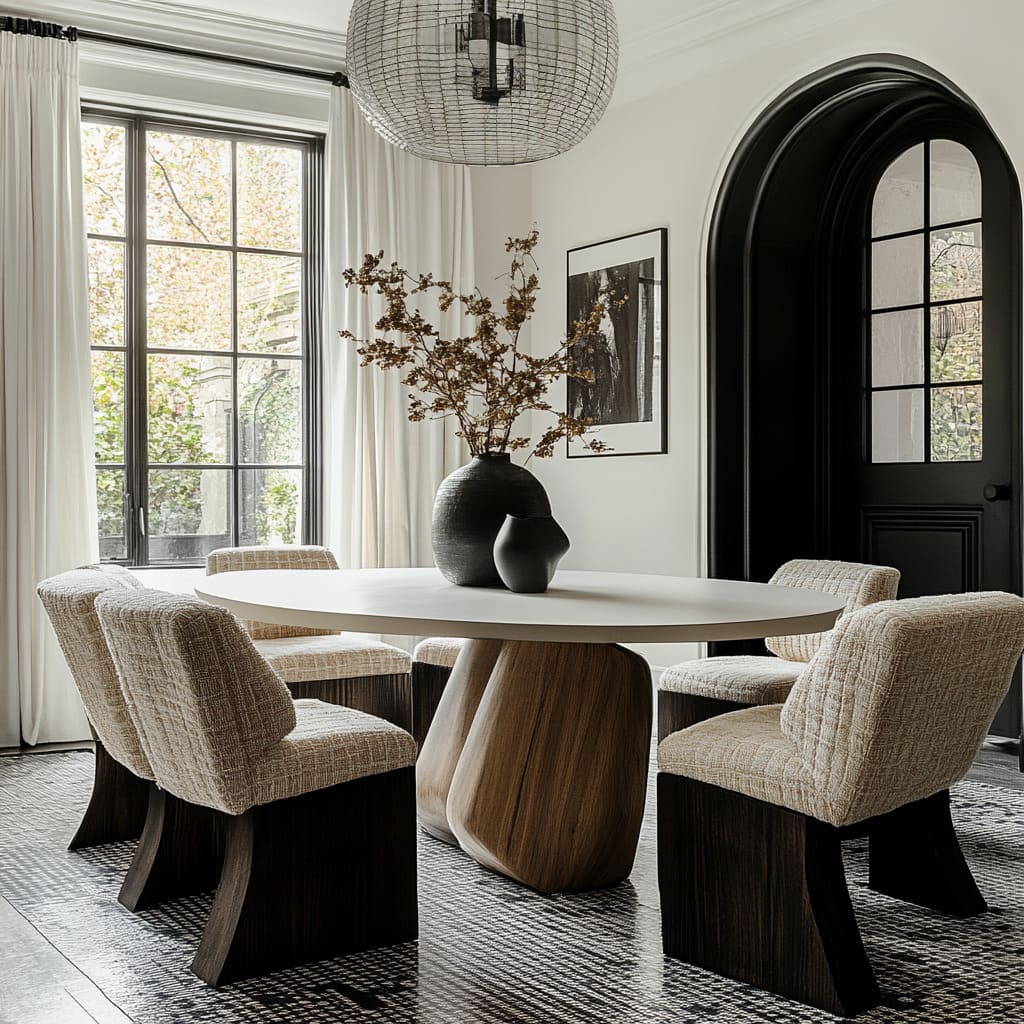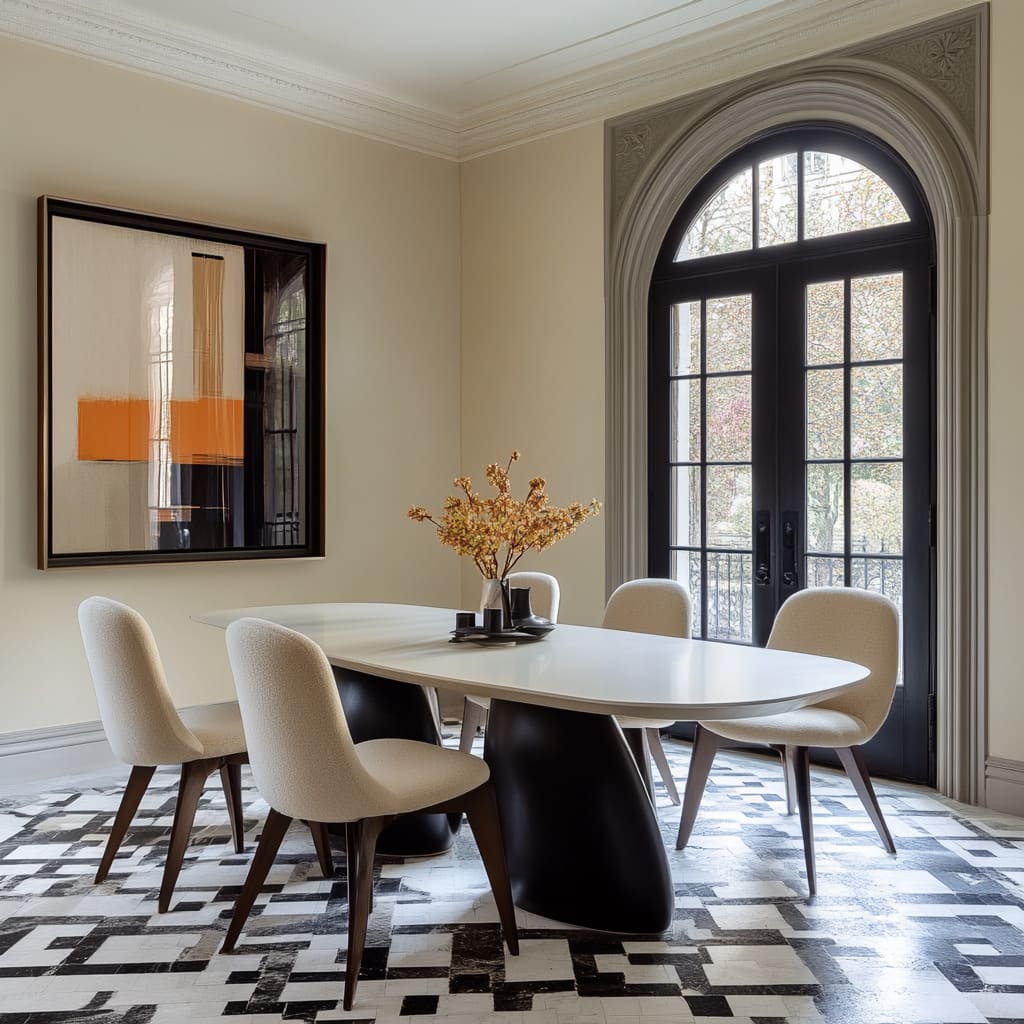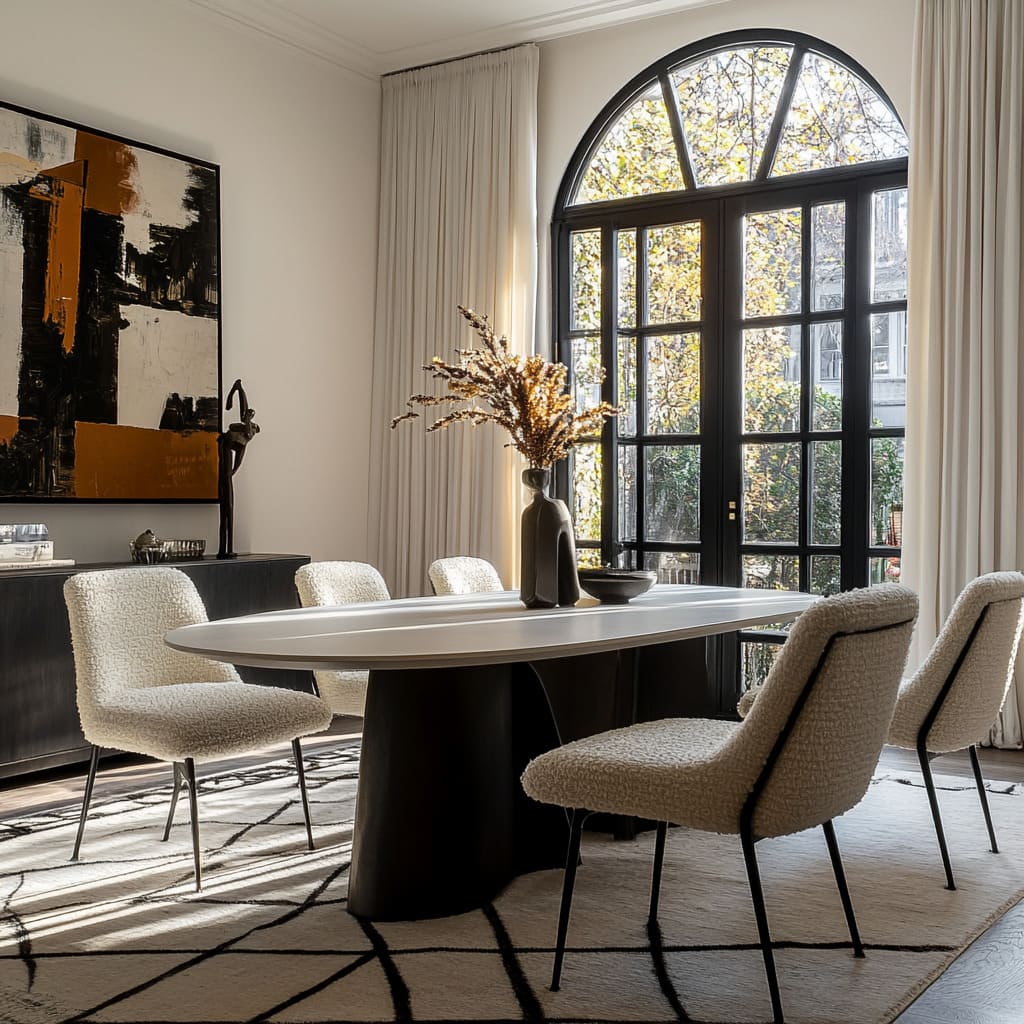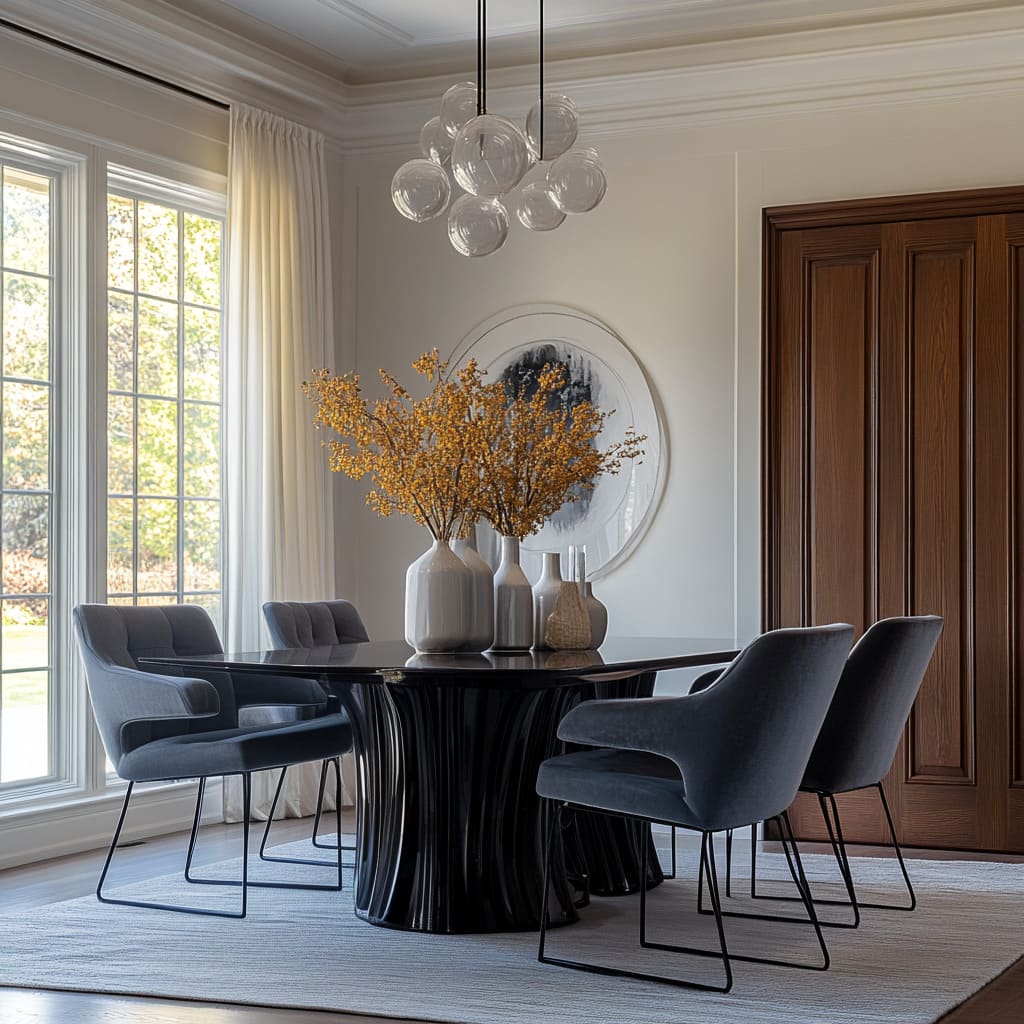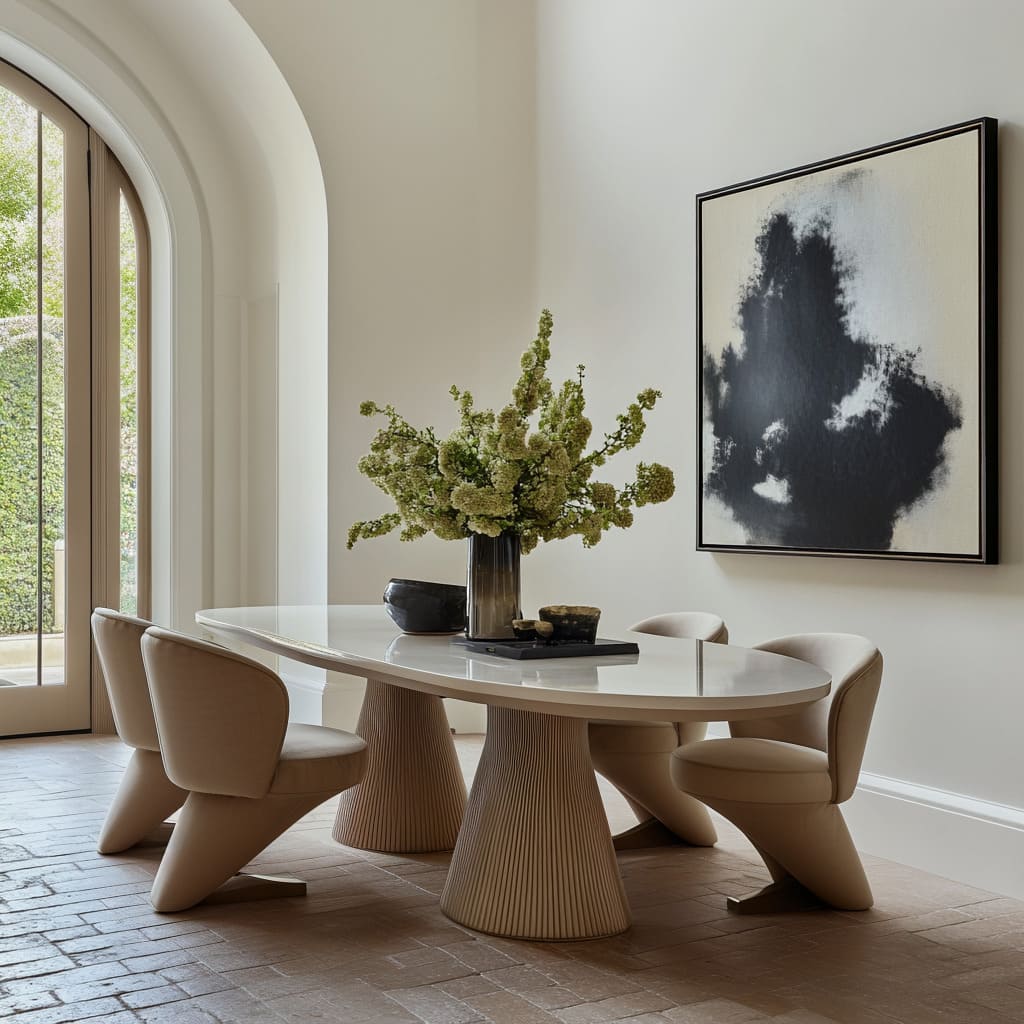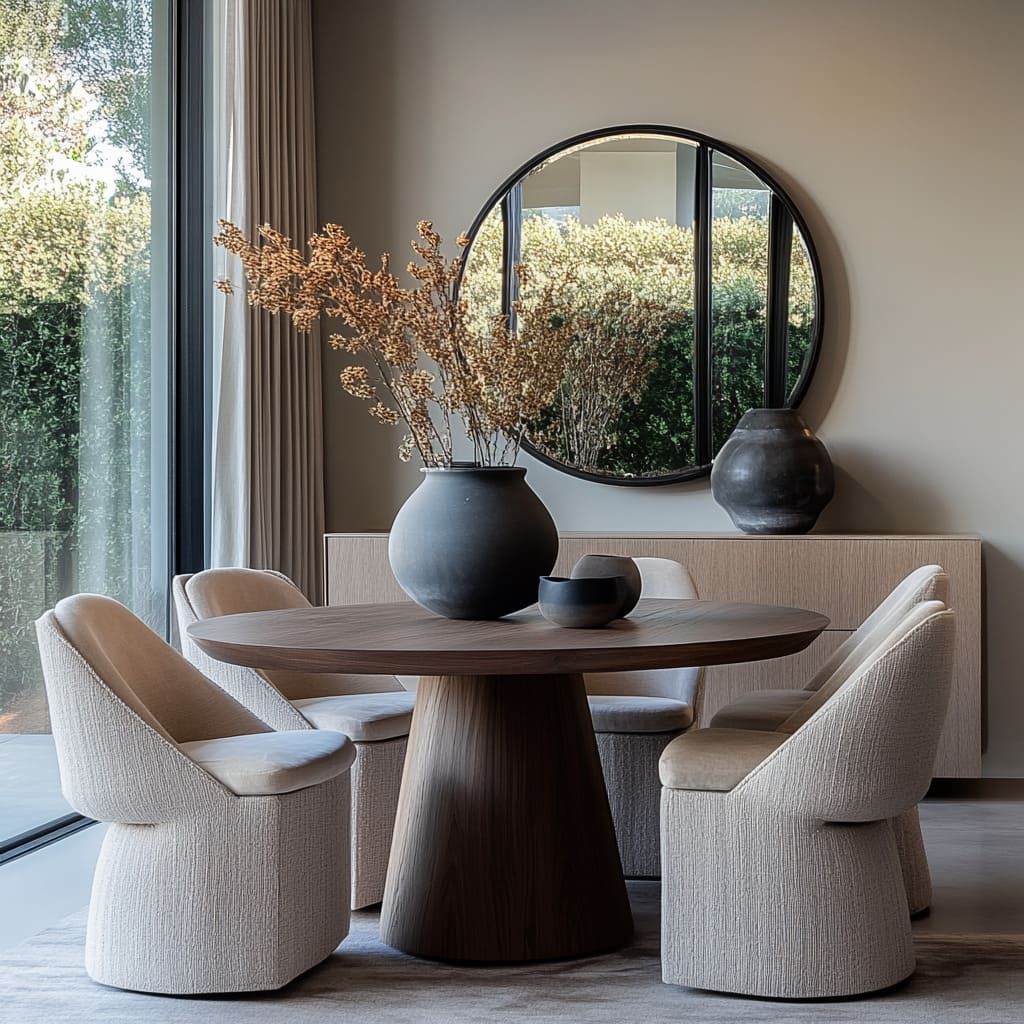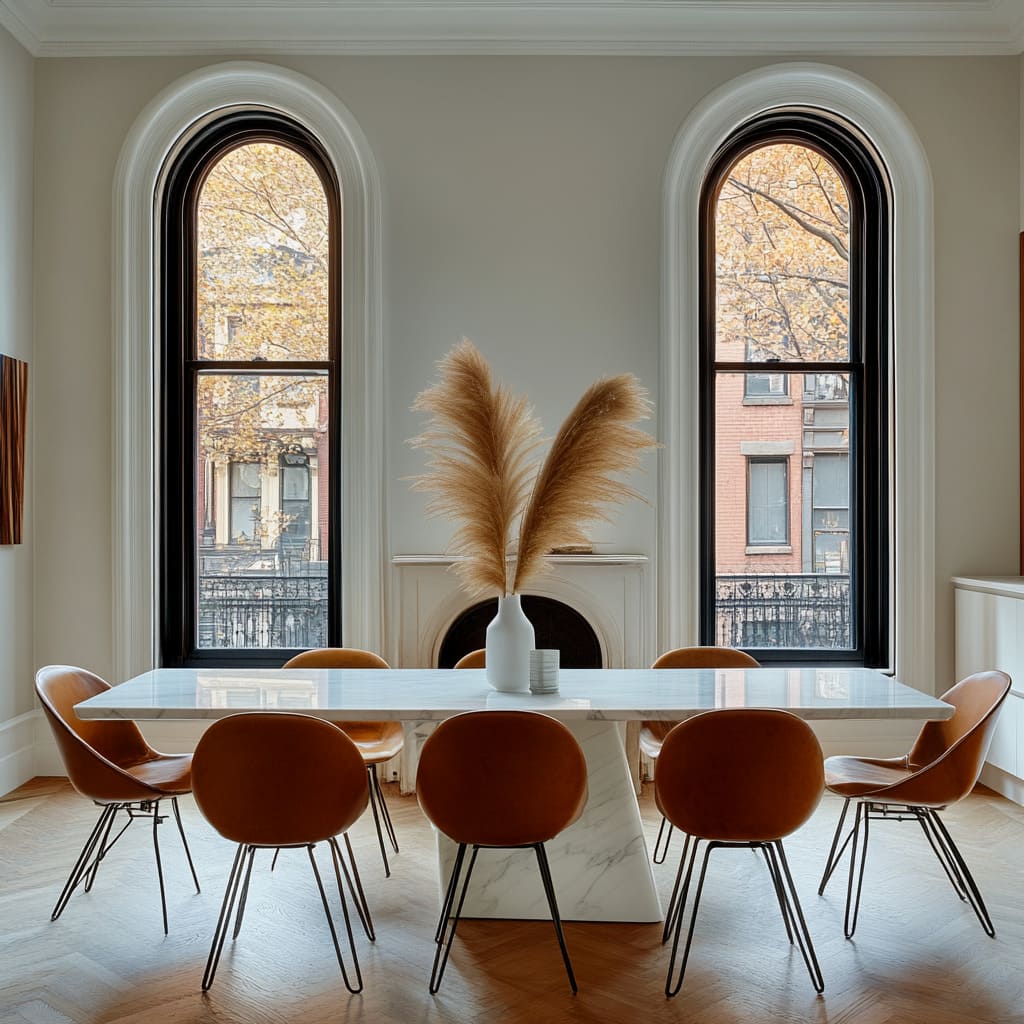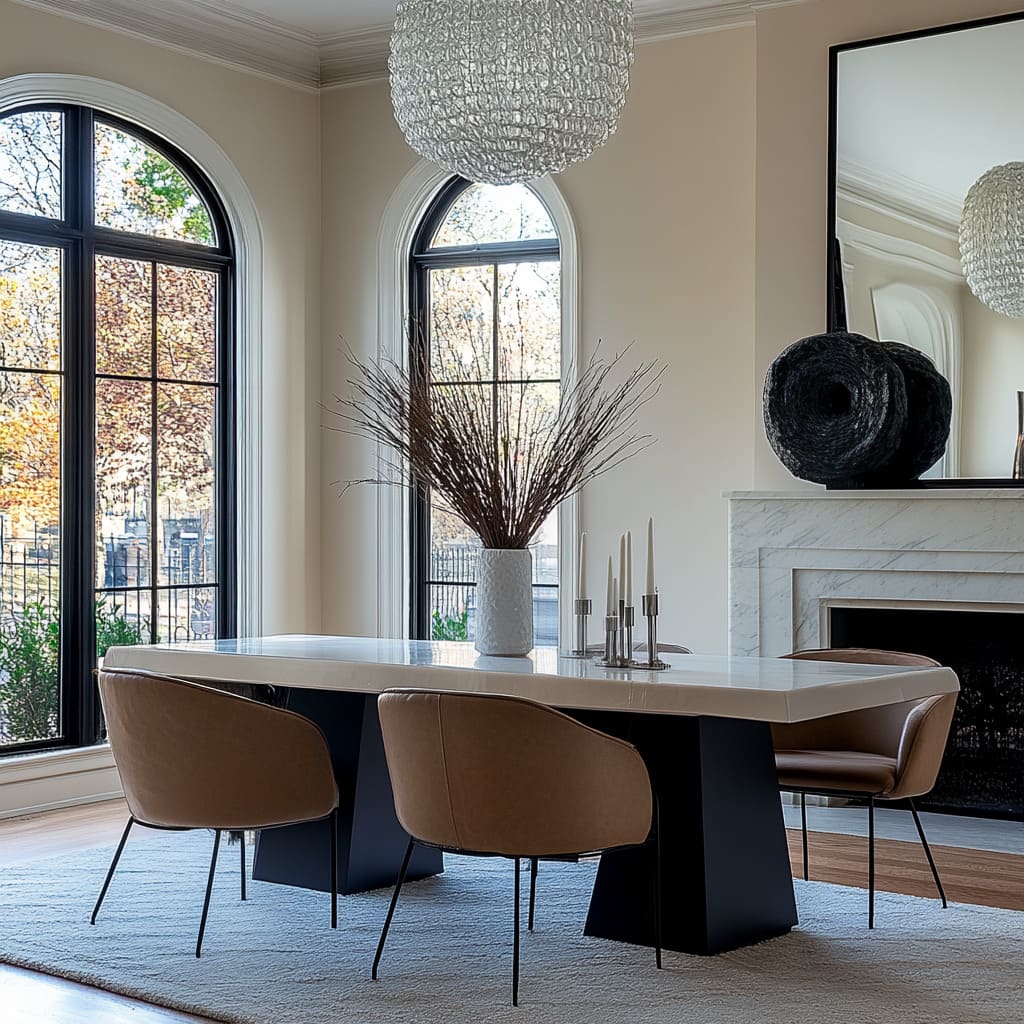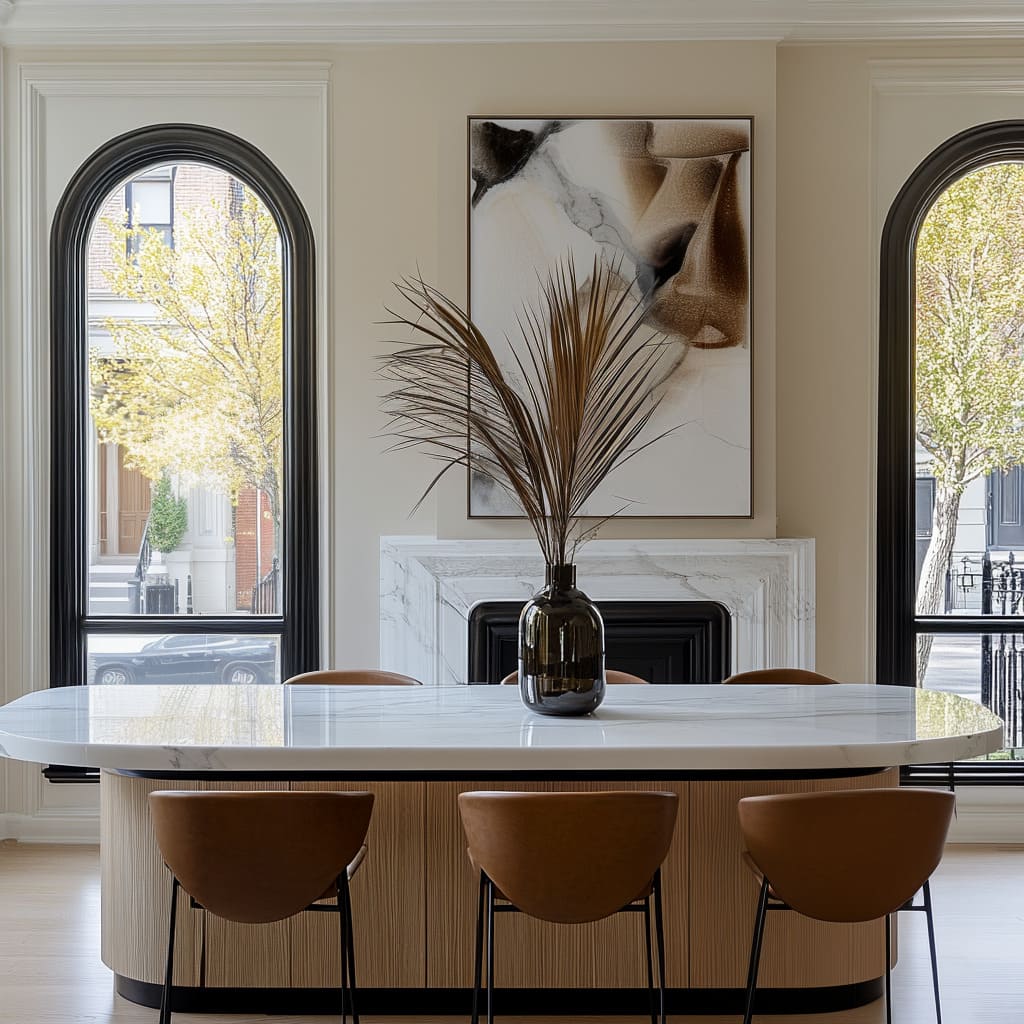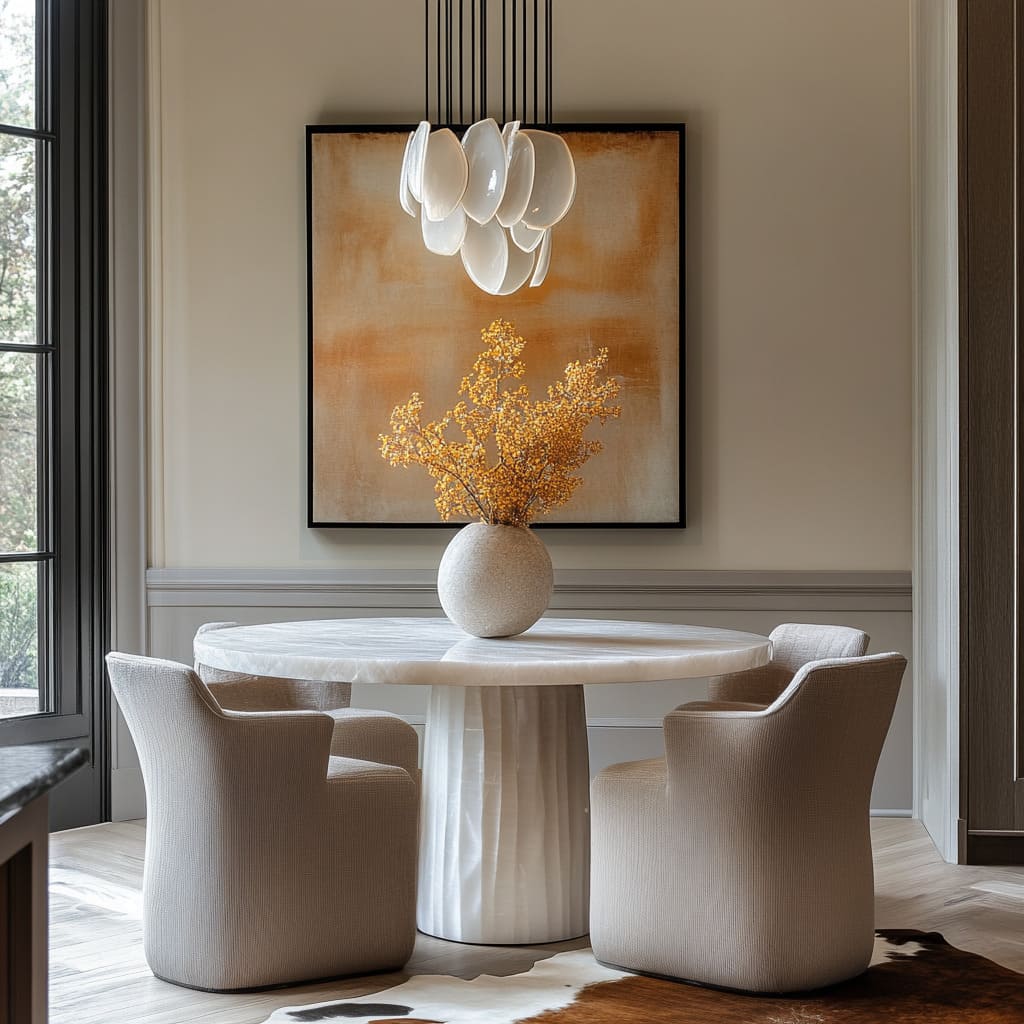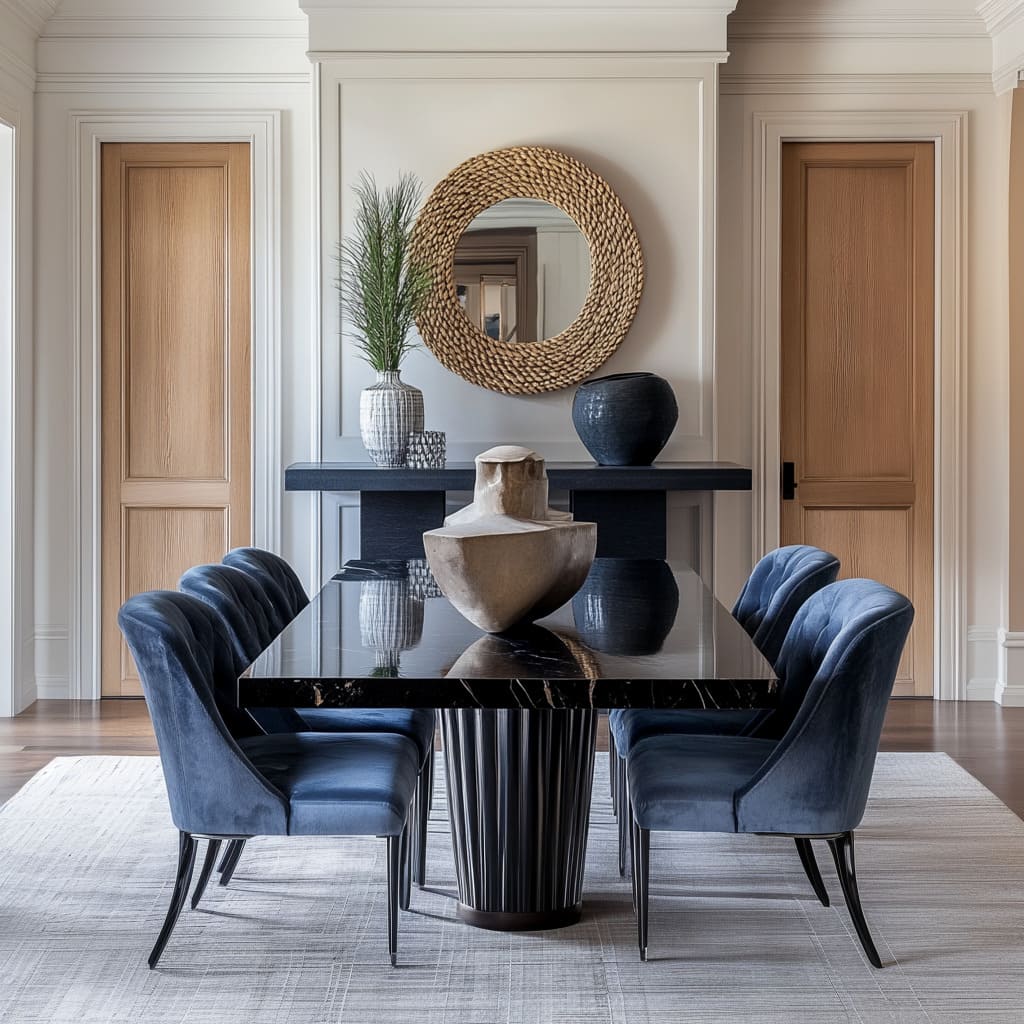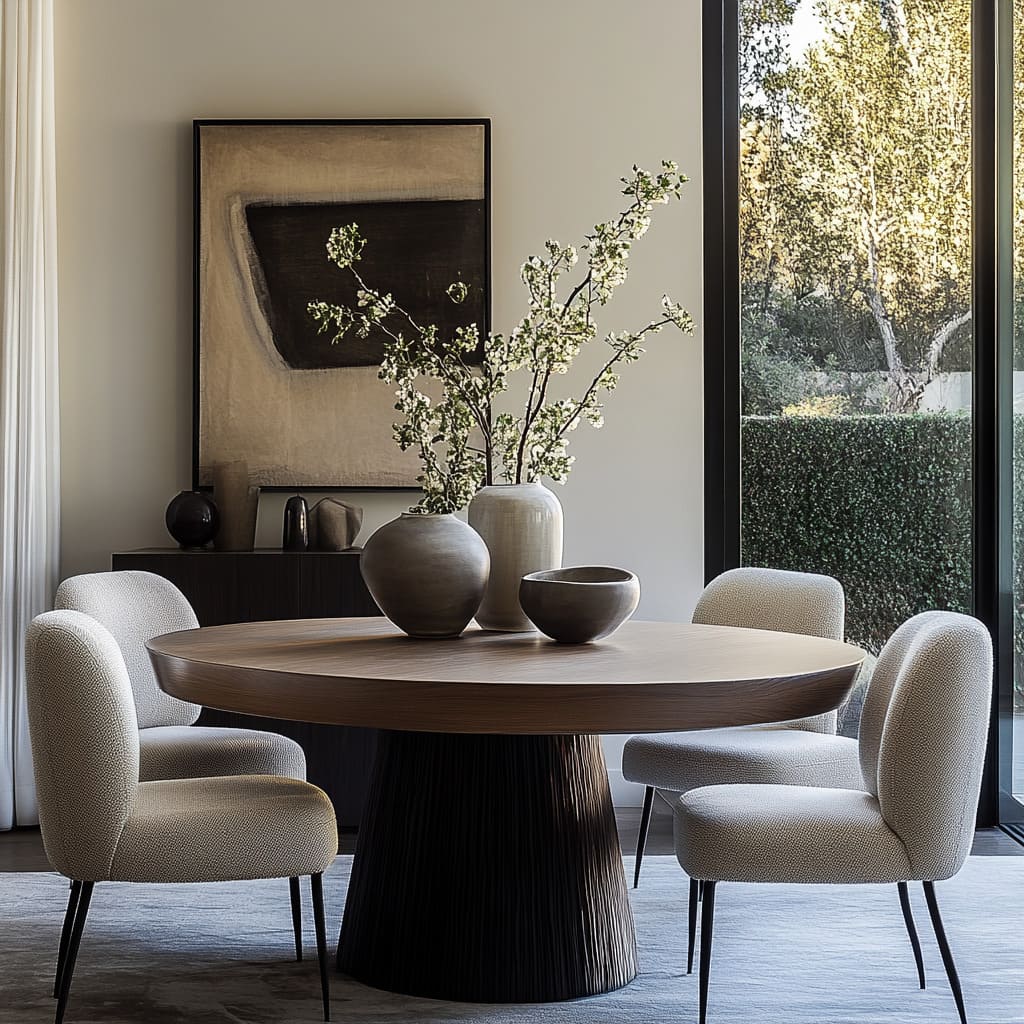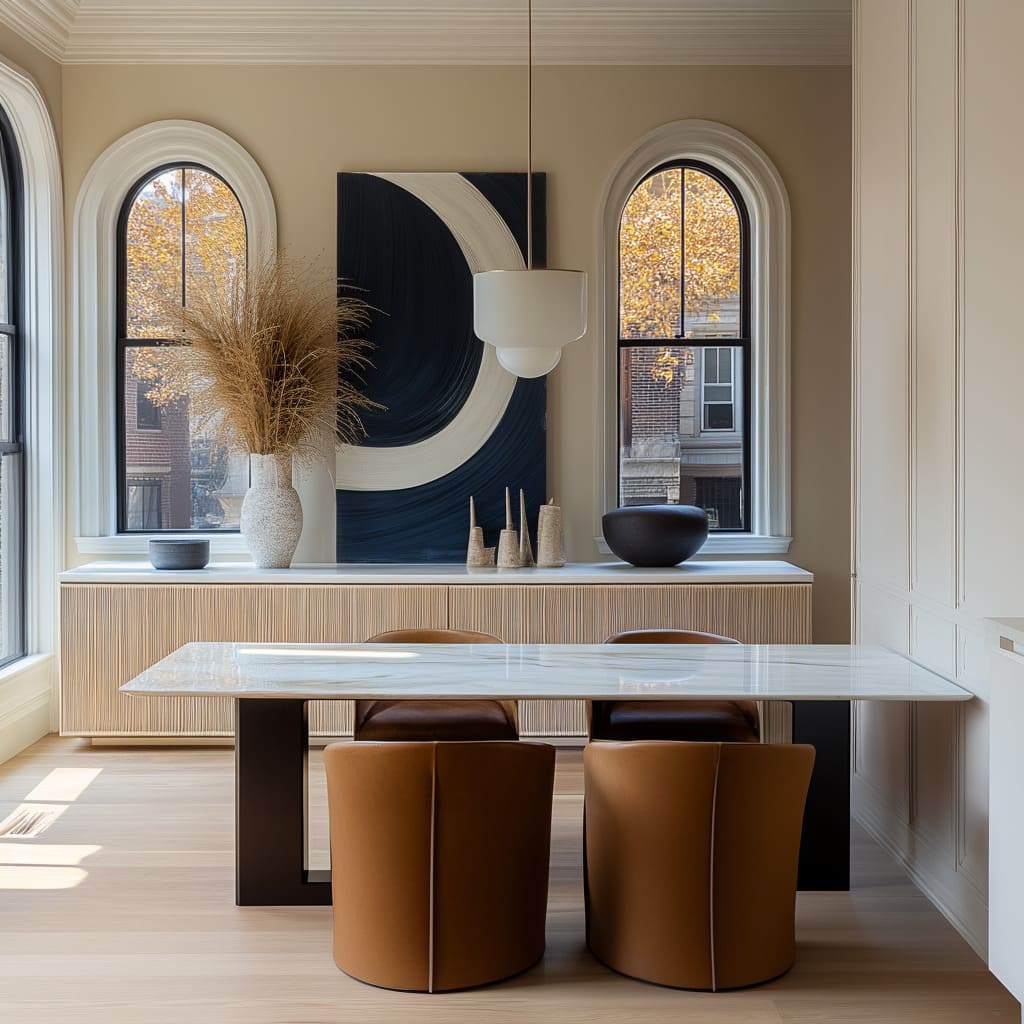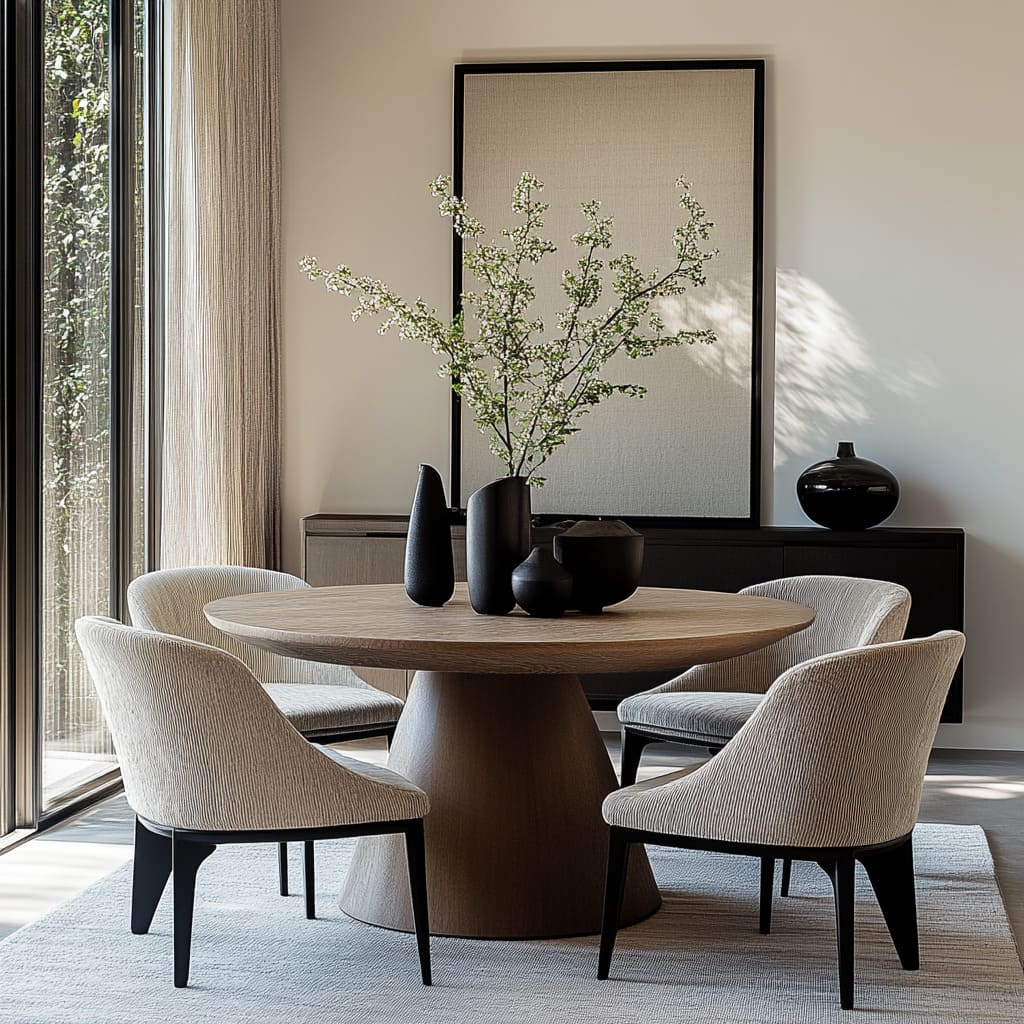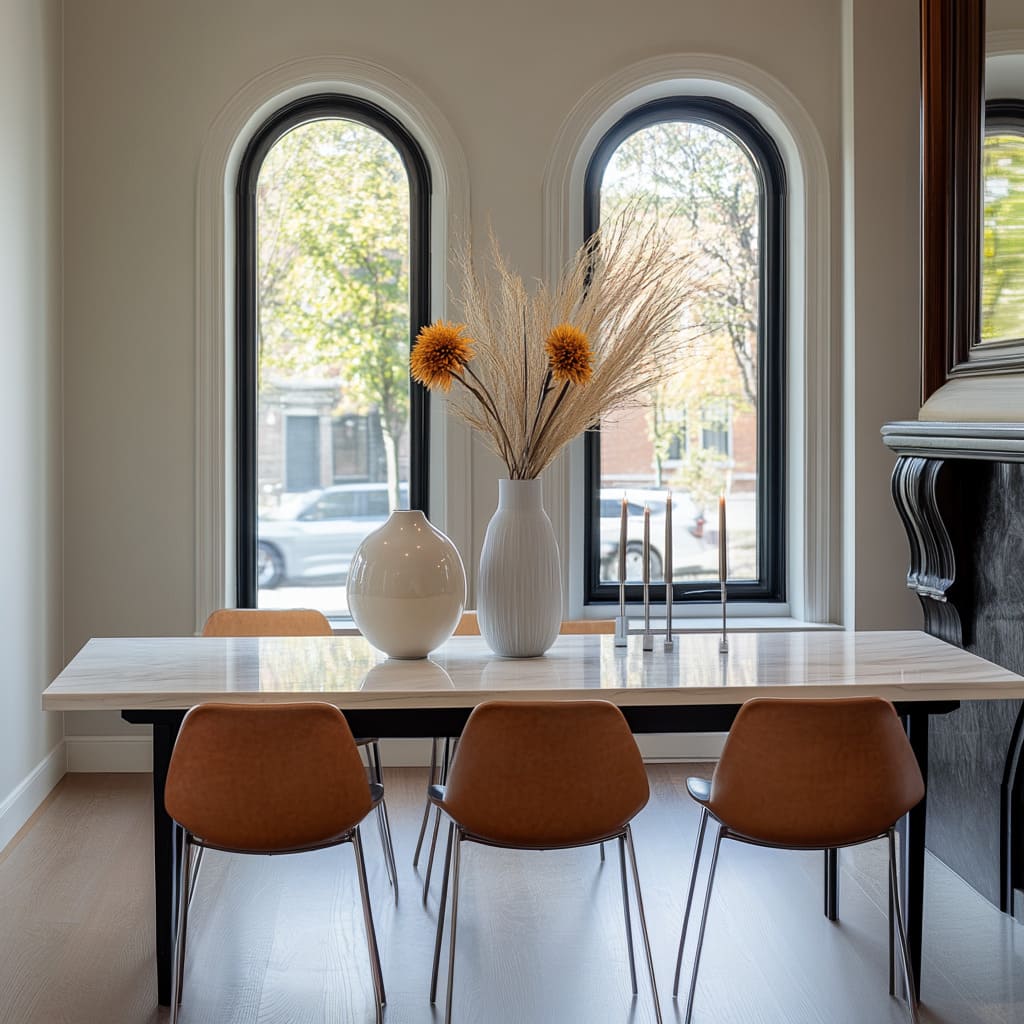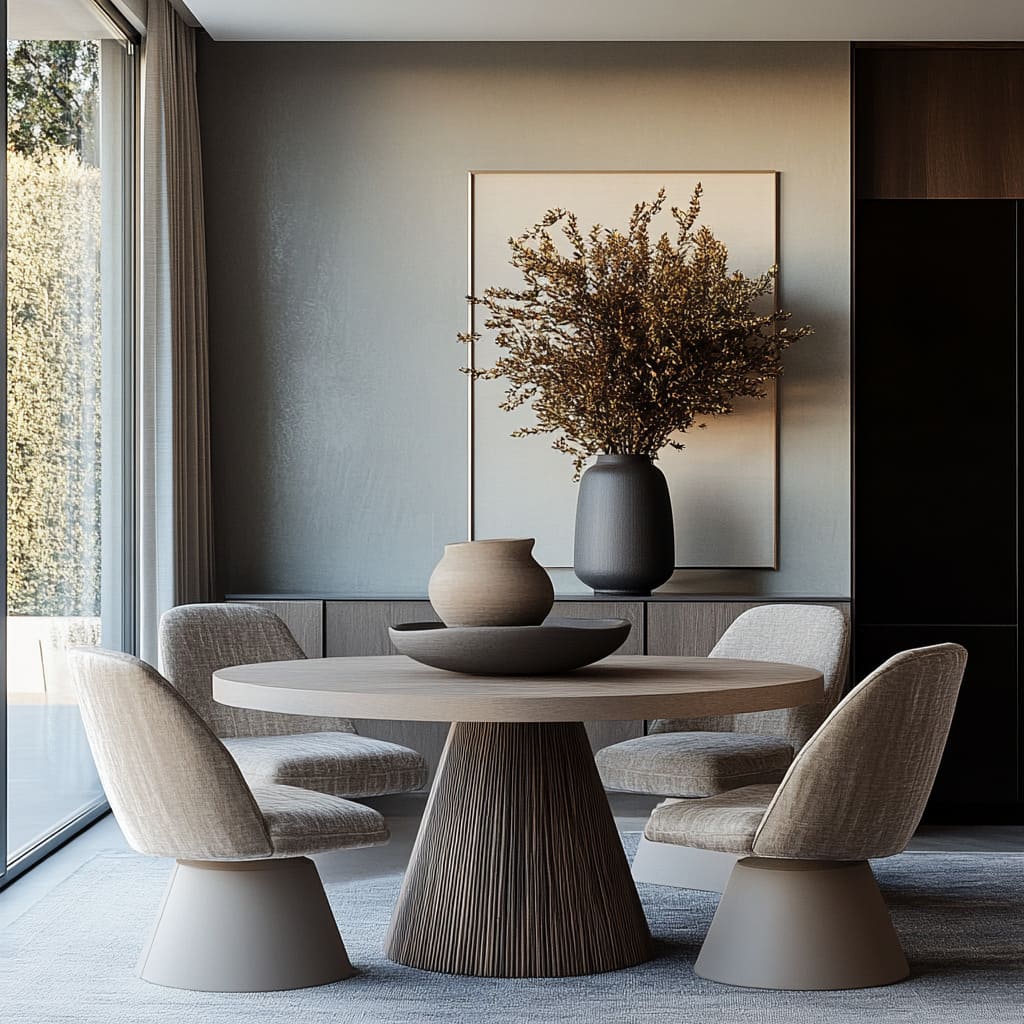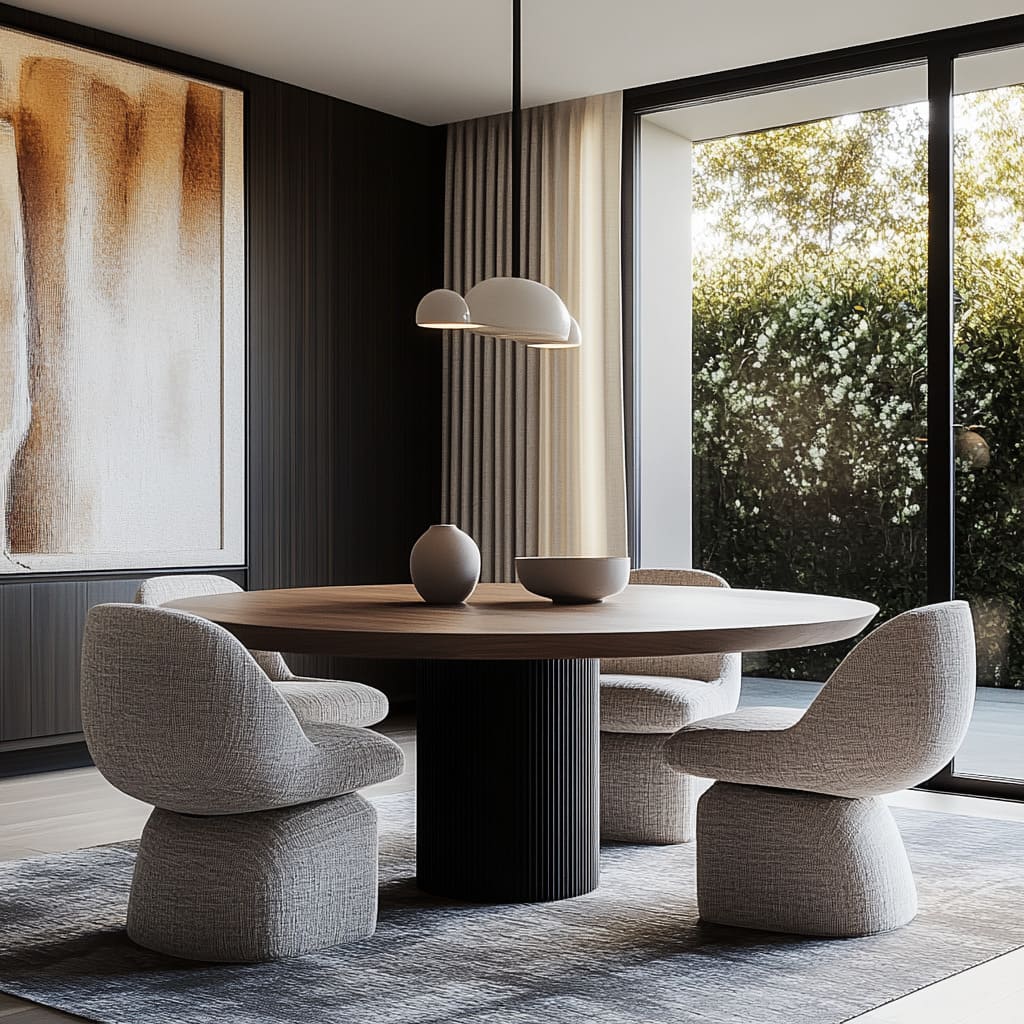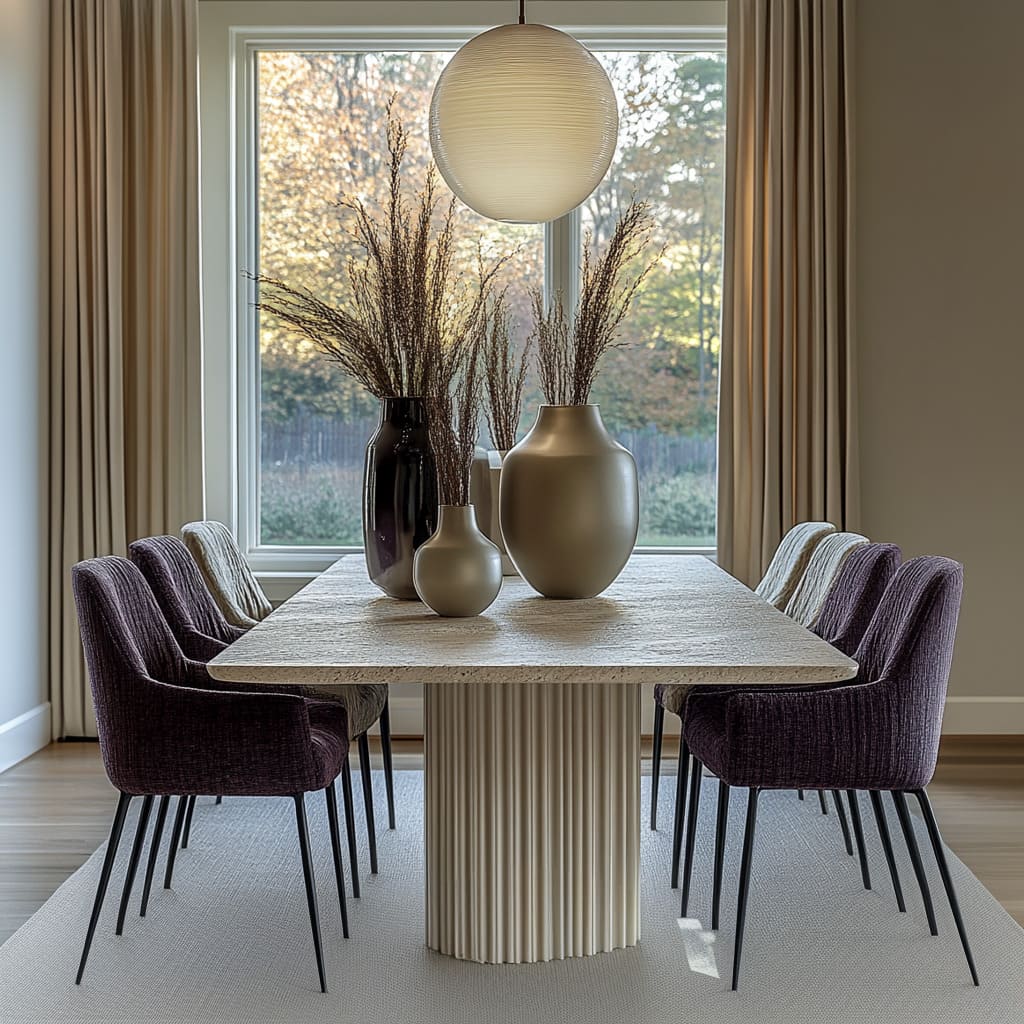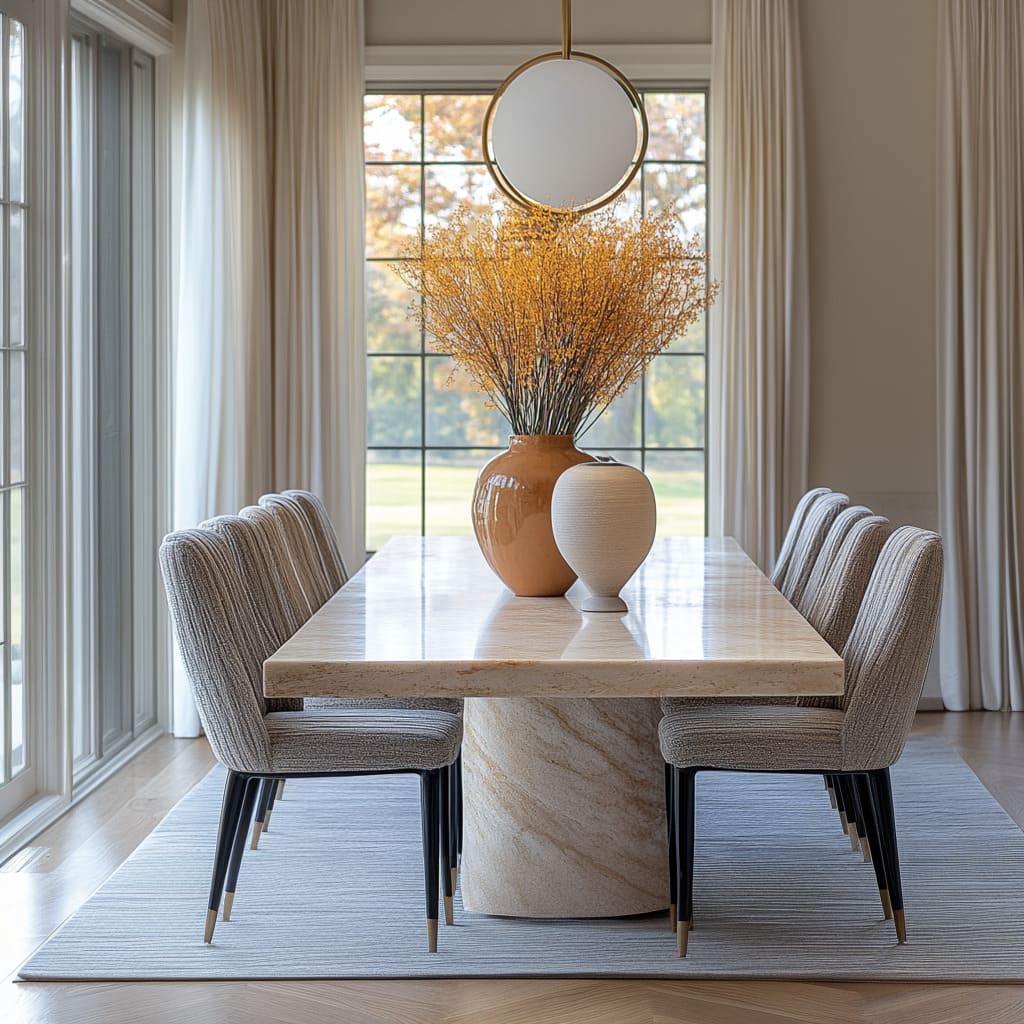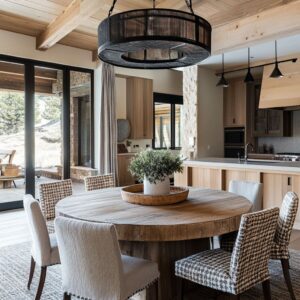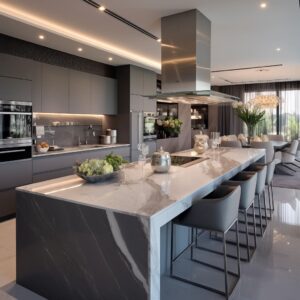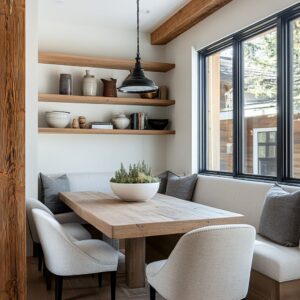Dining rooms have long been a space where function meets style, but today’s table and chair designs bring much more to the conversation than just utility. This article explores how dining tables and chairs have become design statements, carefully balancing visual appeal and practicality while shaping the overall dining experience.
Whether it’s the gentle curve of a table leg or the texture of an upholstered chair, thoughtful design elements make dining room interiors feel complete and intentional.
What makes dining tables and chairs such integral components of a dining room? Their ability to anchor the space while allowing other features—like lighting, artwork, and flooring—to complement the room’s overall personality.
From sculptural bases to smooth, polished finishes, dining tables no longer act as simple furniture pieces; they become focal points that set the tone for the rest of the room. Paired with carefully chosen chairs, they can enhance or soften architectural features, add texture, and create a sense of flow.
This article dives into dining room furniture ideas that blend trends with timeless style. By analyzing key design principles and the latest features in tables and chairs, it provides insights into how the choice of materials, proportions, and decorative touches work harmoniously with the dining room interior.
Whether you’re drawn to natural wood tones, sleek stone finishes, or fabric accents that add warmth, the modern dining room thrives on balance and purpose. Prepare to explore unique combinations, fresh design concepts, and less obvious ideas that elevate dining room aesthetics.
With careful attention to both form and function, dining tables and chairs can transform an ordinary dining space into a reflection of thoughtful, inspired design.
Key Design Elements in Dining Tables and Chairs
The thoughtful blend of materials, shapes, and finishes in dining table designs creates furniture that functions as both practical tools and statement pieces in modern interiors. These elements, when paired thoughtfully, bring character, style, and a sense of visual harmony to dining spaces.
Whether it’s a sculptural base or an unexpected fabric choice, every detail contributes to the overall balance of the room.
Materials and Finishes
Dining tables and chairs stand out for their intentional use of premium materials, balancing aesthetics with practicality. Stone surfaces, including black marble with subtle veining and matte white stone, set a tone of quiet luxury.
These polished and matte tops not only offer a timeless appearance but also provide an easy-to-maintain solution for everyday dining.
Wood features prominently in many dining table ideas, adding warmth and texture to the room. Fluted, sculpted, or textured bases create visual interest while remaining functional.
The combination of clean stone tops with tactile wood structures keeps the design grounded and inviting, avoiding visual monotony. On the seating front, leather upholstery emerges as a favorite choice, with tones like caramel, deep navy, and taupe offering a mix of practicality and refinement.
Velvet fabrics make a bolder statement, often in jewel-toned hues such as navy blue. These chairs add softness to spaces dominated by hard materials, providing tactile contrast while enhancing the room’s sense of comfort.
Form and Shape
Shape plays a crucial role in defining the modern dining table, with a clear emphasis on sculptural forms and geometric balance. Oval and round tables have become particularly popular for their smooth flow and practicality.
Pedestal bases—sometimes asymmetrical, fluted, or textured—act as functional art, adding an eye-catching element beneath the surface while ensuring stability. Rectangular tables bring a sense of structure and formality to dining spaces, often featuring bold bases that make them feel substantial and grounded.
Asymmetry is a key feature seen across many dining table designs, adding a sense of movement and modernity, creating pieces that stand out without overwhelming the room.
Aesthetic and Functional Harmony
The designs strike a careful balance between beauty and functionality. Stone and marble tops remain practical for daily use, while wooden bases add organic texture and warmth.
Leather and velvet upholstery ensure durability and comfort, suitable for both everyday meals and special gatherings.
Decorative accents—whether a vase with dried florals or sculptural objects—complete the dining table’s look without cluttering the surface. Such thoughtful touches emphasize that dining tables are not just practical surfaces but focal points within their interiors.
The modern approach to dining tables and chairs showcases a careful combination of materials, form, and practicality. By pairing refined finishes like marble and wood with bold, sculptural shapes, these pieces bring an artistic yet functional quality to dining rooms.
The strategic use of fabrics and upholstery ensures comfort while enhancing the visual appeal, resulting in dining table ideas that remain timeless, balanced, and perfectly in tune with their surroundings.
Trends in Dining Table and Chair Combinations
.
Sculptural Tables as Art
Modern dining table design has evolved into more than functional furniture; it now embraces artistic expression. Sculptural tables, particularly those with fluted cylindrical bases, geometric pedestals, and dramatic black supports, introduce an almost sculptural quality to dining spaces.
These bold forms are especially striking in rooms with neutral backdrops, where the table naturally becomes the centre of attention. The artistry of these tables lies not only in their shapes but in their balance of functionality and aesthetics, doubling as conversation starters and practical surfaces for dining.
The increasing popularity of marble tops paired with daring bases points toward a trend where tables act as design anchors. Designer dining room tables with organic black bases offer fluid, artistic silhouettes that contrast the hard edges of stone or marble tops.
This intentional shift blurs the line between furniture and art, transforming dining tables into sculptural statements that anchor the room while contributing to its overall harmony.
Organic and Natural Influences
A growing emphasis on natural influences has brought organic textures and forms to the forefront of dining table and chair designs. Fluted wood bases stand out as a signature feature, combining the strength of craftsmanship with an organic aesthetic.
These bases offer textural depth while exuding warmth that contrasts the sleek elegance of polished marble or stone. Rounded chairs with soft curves further enhance this organic theme.
Upholstered in materials like caramel-toned leather or textured fabrics, these chairs provide a sense of ease and understated luxury. Their gentle forms reduce visual harshness, making them an ideal complement to the solid, sculptural tables.
By incorporating nature-inspired materials, these designs achieve a timeless look while infusing dining spaces with a feeling of balance and tranquillity.
Contrast as a Design Principle
Contrast plays a significant role in shaping dining spaces, offering visual depth and tactile intrigue. The interplay of dark and light elements creates immediate visual interest.
For instance, black marble tables with veined surfaces stand boldly against neutral-toned upholstered chairs, allowing the eye to appreciate the balance between weight and lightness. Similarly, light stone tops perched on dark, sculptural bases enhance the sense of visual equilibrium, keeping the room dynamic without overwhelming it.
Textures also work as a subtle tool for contrast. Smooth marble surfaces juxtapose beautifully against tactile, fluted wood bases or chairs wrapped in soft velvet.
This layering of textures adds dimension to the design. The result is a visually rich combination where every element feels intentional, from the luxurious materials to the tactile experience they offer.
Functional Harmony with Artistic Flair
The brilliance of these dining table and chair combinations lies in their ability to balance function with aesthetic appeal. Sculptural tables, organic elements, and contrasting textures all work in unison to create dining rooms that feel curated yet livable.
The tables act as centrepieces, anchoring the room with their bold shapes, while chairs introduce comfort and warmth through soft curves and tactile finishes. By marrying natural influences with artistic shapes, these trends highlight how dining tables and chairs can reflect personal style while enhancing the dining experience.
The blending of sculptural beauty with functional design ensures that the dining area becomes more than a place to sit—it becomes a visually compelling part of the home, where form and purpose meet seamlessly.
Design Principles and Their Role in Dining Room Interiors Balance and Symmetry
Symmetry plays a significant role in dining room table designs, bringing order and harmony to interiors. This principle is particularly evident when dining tables are carefully centered in a room, flanked by evenly spaced chairs and framed by symmetrical elements.
The visual rhythm created by such layouts allows bold table designs—whether marble, wood, or sculptural—to take center stage without creating visual chaos. Symmetry enhances the room’s structure, offering a clean foundation that feels visually grounded.
Beyond the placement of furniture, symmetry influences the relationship between bold dining tables and their surrounding elements. Balanced contrast prevents any one feature from overwhelming the room, ensuring the table remains the focal point.
Decorative elements like art or light fixtures are often mirrored or centered to maintain a cohesive flow, drawing attention to the dining area without distraction.
Focus on Visual Flow
Smooth visual flow is essential when designing a functional and inviting dining area. Rounded tables and curved chairs create a natural sense of movement, making it easier to move around the table and lending a welcoming aesthetic.
The use of rounded edges on chairs and sculptural bases on tables ensures that there are no jarring visual stops. In elongated spaces, oval dining tables are especially effective.
Their shape mirrors the linear architecture of the room while softening the overall impact. This connection between table design and architectural flow creates continuity, making the dining area feel thoughtfully integrated with the rest of the space.
Focal Points and Anchors
A dining table often functions as the anchor of the room, setting the tone for everything else. Modern dining rooms frequently emphasize bold table bases—geometric shapes, fluted structures, or asymmetrical forms—that serve as visual focal points.
These bases bring artistic flair to functional furniture, grounding the room’s design.
To enhance the role of the table as the focal point, decorative elements are chosen and placed strategically. Sculptural vases, dried florals, and minimal arrangements highlight the table’s design without overshadowing it.
The careful balance of these elements ensures the table feels like a natural centerpiece, not an over-decorated distraction.
Harmony Between Function and Aesthetics
Successful dining room table designs balance functionality with visual appeal. A table’s shape, material, and placement must suit practical needs while enhancing its aesthetic.
Sculptural tables with bold bases provide stability while acting as conversation pieces. Chairs—upholstered in leather, velvet, or textured fabrics—soften the look of these bold tables, maintaining comfort and usability.
This harmony extends to how the dining table works within the greater interior. Chair placement, rug choices, and natural lighting enhance the table’s impact, ensuring it becomes part of a larger, sophisticated composition.
By blending practicality with thoughtful design, these dining spaces transform interiors into welcoming environments that balance beauty and function.
Ideas and Unique Combinations
Sculptural Furniture Reflects the Room’s Architecture
Dining tables with sculptural bases establish a subtle connection to the room’s architectural elements, creating an organic dialogue between furniture and space. For instance, tables with rounded or curved bases mirror arched windows or doorways, reflecting the soft lines of classic architecture.
This repetition of shape draws the eye naturally around the room, achieving visual balance without overt effort. In rooms with sharper angles—like rectangular window panes or straight crown moldings—rounded tables act as a soft counterpoint, breaking the rigidity and creating a harmonious contrast.
In some spaces, triangular or fluted marble table bases introduce geometric contrast in rooms with more fluid, curved forms. The juxtaposition of sharp geometry against soft contours prevents the room from feeling overly uniform and introduces visual intrigue.
This connection between form and surrounding architecture ensures a cohesive design where the dining table doesn’t merely occupy space but contributes to the overall structure of the interior.
Textural Layering for Depth
A recurring feature across these dining table design ideas is the layering of textures to introduce subtle depth while maintaining a cohesive aesthetic. Fluted bases and sculptural pedestal forms bring tactile qualities that work seamlessly within restrained, neutral palettes.
When paired with grainy wooden surfaces, polished stone tops, or soft velvet chairs, these textural contrasts add dimension without overwhelming the eye. Smooth surfaces, such as marble or matte stone tabletops, ground the composition.
Chairs also play an integral role in textural balance. Upholstered seats in rich fabrics like velvet or warm-toned leather provide tactile softness that contrasts beautifully with the solidity of tables.
This restrained yet varied mix of textures prevents the room from feeling flat, encouraging visual exploration while retaining a sense of serenity.
Natural Light Enhances Contrast and Shapes
The placement of dining tables and chairs to capitalize on natural light is a strategic design choice that enhances both form and function. Many tables are positioned near tall windows, allowing light and shadow to bring the room to life.
Natural light reflects off polished stone tops—especially marble—accentuating their veined surfaces and adding movement to the design. At certain angles, light softens bold forms, blending them seamlessly into the room’s atmosphere.
Rounded chairs benefit from this illumination, as soft light highlights their curves and contours. Subtle shadows cast on fluted or grooved table bases further enhance their texture, creating depth and dimension throughout the day.
This thoughtful interaction ensures every detail is appreciated, making the dining area feel fresh and intentional.
Neutral Palettes Amplify Bold Forms
Neutral backdrops—beige walls, natural wood flooring, and subtle rugs—have become essential in highlighting the artistry of modern dining tables and chairs. This approach ensures that bold dining table design ideas remain the focal point, letting form, texture, and material combinations shine without competition.
To add warmth and personality, pops of color appear in the choice of chairs. Caramel leather seating introduces an inviting tone that contrasts beautifully with stone tables, while navy velvet chairs lend depth and sophistication.
These thoughtful pairings enhance the overall design without overwhelming the room, resulting in interiors that feel curated, cohesive, and celebratory of the dining furniture’s beauty.
Practical and Aesthetic Considerations
Practicality
The dining tables described here masterfully balance visual appeal with functionality, making them suitable for everyday use and formal gatherings alike. Stone and marble tops are highly durable, resisting scratches and stains, while easy to clean surfaces ensure a practical solution for families or frequent hosts.
Chairs upholstered in leather offer durability and resistance to spills, aging gracefully and adding character over time. In more formal settings, velvet upholstery introduces texture and opulence, elevating the room’s overall atmosphere.
Comfort
Comfort is a central priority in choosing dining chairs, with rounded, high-back designs ensuring supportive and relaxed seating. Plush upholstery—whether velvet or woven fabrics—adds tactile warmth, encouraging guests to linger comfortably at the table.
By blending ergonomics with style, these chairs prove that comfort and visual appeal can coexist, making the dining experience both pleasant and refined.
Aesthetics
The tables often transcend mere utility, functioning as sculptural focal points within the dining area. Unique bases—fluted, asymmetrical, or geometric—serve as eye-catching conversation starters, allowing the table to anchor the space with a sense of artistic presence.
Chairs, chosen for their complementary role, maintain understated palettes and gentle curves that echo the table’s contours, ensuring a cohesive and visually flowing arrangement.
Creating Cohesive Dining Area Ideas
A well-curated dining area seamlessly integrates practicality and aesthetics, with sculptural tables and ergonomic chairs working together to reinforce balance and cohesion. Neutral backdrops and layered textures create inviting and thoughtfully designed spaces, while the use of materials like stone and leather achieves a balance between luxury and everyday usability.
By aligning form, function, and comfort, these interiors become environments that celebrate dining furniture as both necessity and statement.
Conclusion: Overall Insights and Trends
The modern design of dining area spaces continues to redefine how we view and use tables and chairs, seamlessly blending functionality with artistic expression. Sculptural tables have emerged as more than just furniture; they anchor the room with their dramatic bases and refined tops, becoming statement pieces that draw the eye and spark conversations.
These designs prove that dining tables can act as functional art, enriching the overall character of the room while maintaining practicality.
Material contrast plays a pivotal role in creating depth and interest. The combination of marble, wood, leather, and fabric showcases a mastery of layering textures and tones.
Smooth marble or stone tops pair effortlessly with tactile wood bases, while velvet or leather upholstery introduces softness, warmth, and richness. This thoughtful juxtaposition not only enhances the table and chairs but also contributes to the overall balance of the dining area.
Harmony within the interior is achieved by ensuring that tables and chairs respond to the architectural and textural qualities of the room. Whether through rounded edges that soften sharp architectural lines or bold bases that echo the symmetry of the space, every element is designed to complement its surroundings.
This intentional connection between furniture and environment maintains visual flow and cohesion, making the dining area feel unified and well-considered.
Striking the right balance between form and function is the cornerstone of these designs. The bold forms of sculptural tables and the inviting materials of chairs prioritize both comfort and aesthetics.
The result is dining spaces that are as practical as they are visually compelling. Every detail, from the table’s base to the fabric of the chairs, contributes to an atmosphere that feels refined, balanced, and timeless.
By blending comfort with artistry, modern dining rooms achieve an enduring appeal that enhances both everyday use and special occasions.
